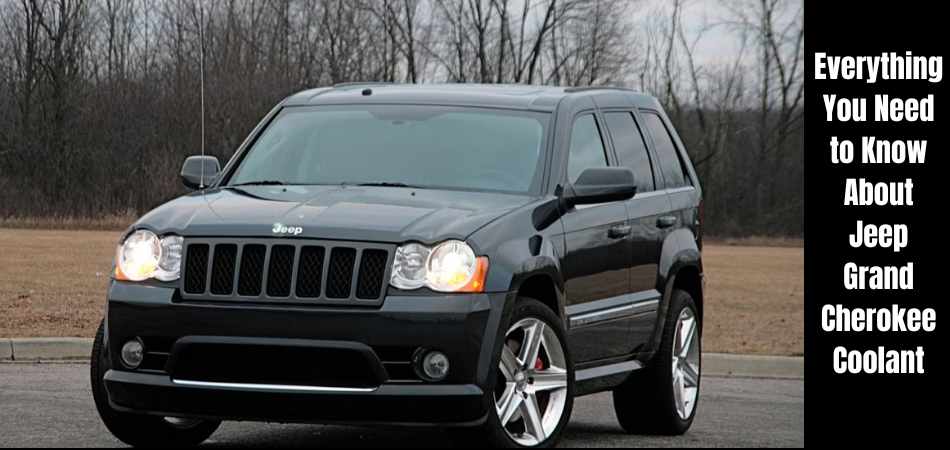
Jeep Grand Cherokee Coolant are natural liquid or gas used to regulate the Jeep engine’s temperature. In most cases, liquid coolants consist of half water and half ethylene glycol. In order to reduce the chilled point of liquids, water is used to transfer heat, and ethylene glycol to transfer heat.
It can be difficult to get the right kind of coolant for your Jeep Grand Cherokee. So what kind of coolant should you use in a Jeep Grand Cherokee? Every Jeep Grand Cherokee driver knows the importance of refueling and changing the oil or brake fluid regularly. A less frequent question is how often to change the coolant.
It is important to replace this fluid on time to prevent your Grand Cherokee’s engine from overheating, which is a very dangerous malfunction, which can also occur on a congested highway.
To prevent this, let’s figure out together when and how to change the Jeep Grand Cherokee Coolant and which one to use.
What is The Function of Engine Coolant?
Are you wondering what exactly car coolant is? To keep your car running at its best, coolant transfers heat and adds antifreeze protection.
The combustion of fuel creates energy in internal combustion engines. A portion of this energy is harnessed by the engine and used to propel the vehicle forward. As energy remains, heat is produced.
A portion of this heat escapes through the exhaust pipe. In the engine block itself, the rest remains.
Combustion temperatures average over 2,000°F and can reach 4,500°F in some instances. Melting temperatures for aluminum components are around 1,225°F.
In some ways, engine cooling problems cause many engine failures. The engine coolant protects the engine and keeps it at the optimal temperature.
How Does Jeep Grand Cherokee Coolant Work?
During engine operation, coolant is collected in a reservoir attached to the radiator before being introduced to the engine block.
Liquid cooling systems combine engine coolant with engine coolant. There are several components that make up the liquid cooling system.
- Coolant circulates throughout the system thanks to the water pump.
- Radiators conduct heat away from coolants.
- It is the radiator hoses that connect the various parts of the cooling system.
- If the vehicle does not move fast enough, the fan draws air through the radiator.
- The thermostat regulates the coolant’s temperature.
Coolant circulates continuously through the engine and back through the radiator while the engine is running. Upon cooling, coolant exits from the bottom of the radiator. It then flows into the engine’s water pump, which pumps it into the engine’s block and head to absorb excess heat. A second cooling process occurs at the top of the radiator where the coolant is returned.
What Kind of Coolants Are Available for the Jeep Grand Cherokee?
We recommend checking your manual first, since different years of Jeep Grand Cherokee may have slightly different antifreeze formula requirements. Jeep Grand Cherokee owners’ manuals should provide suggestions about what antifreeze to use, if not a brand and mixture.
The following are some examples of antifreeze you might be asked to use. You will also find information in your manual about how often you should change your antifreeze.
1. INORGANIC ADDITIVE TECHNOLOGY
If your Jeep Grand Cherokee was built before 1990, you may find this type of antifreeze in your manual. Even though Jeeps can last that long with some tender, loving care, you probably won’t put this type of antifreeze in your Jeep unless the manual says so.
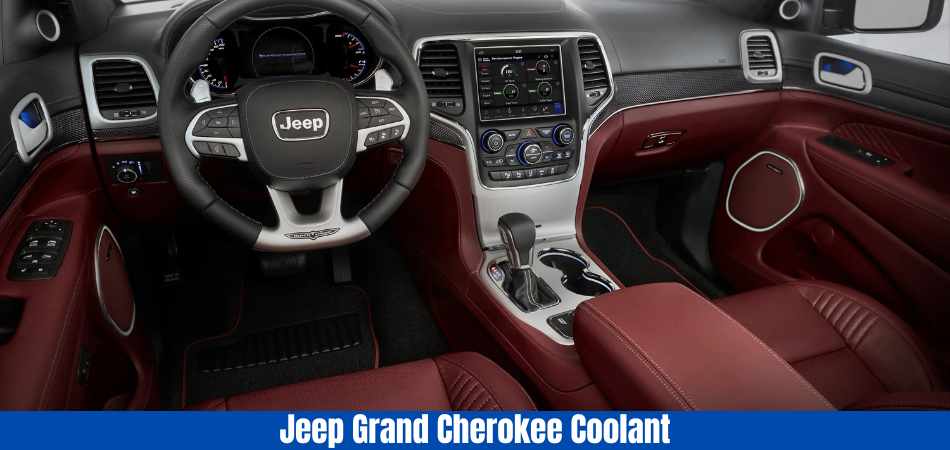
Green is perhaps the most distinctive characteristic of IAT antifreeze. If you have a leak or spill, you’ll definitely know! This type of antifreeze was not very effective, and it had to be replaced every couple of years.
2. ORGANIC ACID TECHNOLOGY
The main advantage of OAT acid over IAT is that it can last much longer. Unlike silicates or phosphates, this type of antifreeze is much less corrosive. There are a variety of colors of OAT coolants, including red, yellow, orange, purple, and blue.
In about ten years or 135,000 miles, your Jeep will need to have this changed. Most likely, your Jeep will ask for this type of antifreeze if it was built after 2013.
3. HYBRID ORGANIC ACID TECHNOLOGY
Newer vehicles require HOAT. Although Jeep recommended this type of antifreeze up until 2013, you’re more likely to find it in German or Asian cars.
To prevent aluminum corrosion, some silicates were added back in. By removing particles that would otherwise contaminate the vehicle’s coolant, corrosion inhibitors enhance the cooling system. It lasted only 5 years or 150,000 miles, however.
This type of antifreeze might be suitable for Jeeps built before 2013.
What is the Color of Jeep Grand Cherokee Coolant?
Answers vary depending on the year. Most Jeep Grand Cherokee models built after 2013 use yellow, red, purple, or blue antifreeze. You will probably find yellow, blue, purple, pink, or even turquoise if it was built before 2013.
In light of the overlap in colors, it would be better to look at the actual type of antifreeze on the bottle. You probably shouldn’t paint your Jeep Grand Cherokee green unless it’s a 1990 or older model.
Part of the reason for adding colors to antifreeze is to make it easier to spot leaks. It’s not a particularly good indicator of the actual type of material.
What Are The Best Jeep Grand Cherokee Coolant?
Different Jeep Grand Cherokee models and years may require different types and amounts of coolant. There are two types of coolants: OAT (Organic Acid Technology) and HOAT (Hybrid Organic Acid Technology). DEX-COOL is another variation they use.
Does that sound confusing to you? We’ll show you how to determine what kind of coolant fluid to use.
The types of coolant used in automotive service departments can be strange, and we’ve worked with them before. In addition, we realize how important it is to get it right, which is why we will provide some information that will assist you.
What Happens If Your Jeep Grand Cherokee Runs Out Of Coolant?
Having problems with your Jeep Grand Cherokee doesn’t require you to run out of coolant. In order to prevent rust, breakage, or irreparable damage to Jeep Grand Cherokee engine components, dilution levels must be within a satisfactory range.
It is possible for your entire engine system to be compromised if you run out of coolant due to a leak or inadequate fluid levels, including the gaskets, pistons, and even the engine block.
What Are The Main Symptoms Of Coolant Misuse on Jeep Grand Cherokee?
The cavitation erosion that results from improper antifreeze use is one of the most dangerous consequences.
A simple example of cavitation is the boiling of a kettle. During this process, the bubbles collapsing make a buzzing sound.
How does this affect the cooling system of the Jeep Grand Cherokee? Whenever bubbles collapse near the surface of the metal, even over a long period of time, the metal erodes.
Surface grooves appear on the surface, which deepen over time. In metal parts, cavitation can “eat” holes if it is not detected in time.
You can prevent this issue by changing your car coolant regularly, especially if it contains extra additives (but this may not be applicable to all vehicles). Water accumulating in the refrigerant can cause cracks to form.
Furthermore, they can be quite large, causing leaks. By monitoring and updating antifreeze on time, they can be avoided.
Can The Wrong Kind of Coolant Damage Anything?
In fact, it might, especially if you leave it for too long. IAT or older types of antifreeze could harm the metals used in Jeep engines. Water pumps, radiator hoses, radiators, and gaskets in your engine can corrode and rust.
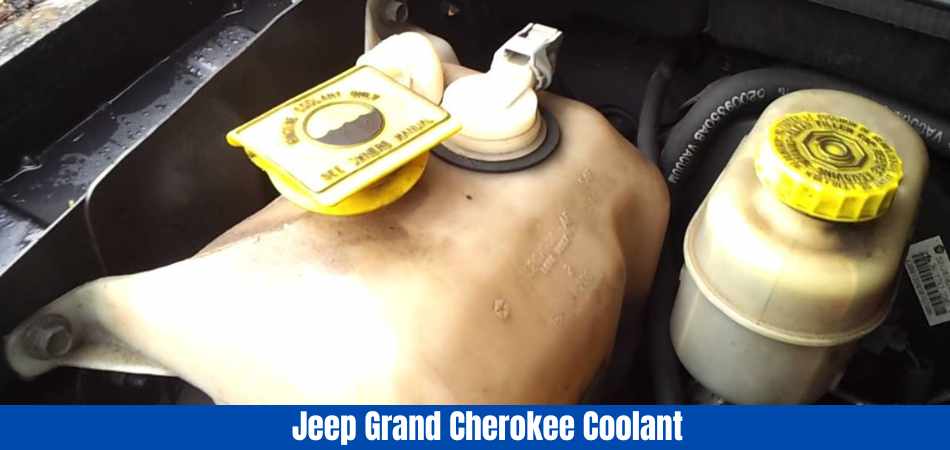
They are designed to work within certain tolerances and to withstand certain chemicals. By using the wrong chemicals, you can prematurely wear out your engine.
If you put the wrong type of antifreeze in, we recommend having it flushed out to avoid further problems.
How Often Do You Have To Change The Coolant In Jeep Grand Cherokee?
Depending on the Jeep Grand Cherokee’s model year, age, and mileage, the coolant needs to be replaced at different intervals.
After 60,000 miles (or four years), it is usually necessary to change the liquid. It is recommended to replace the coolant every 30,000 miles (or every two years).
A coolant level should remain between the “min” and “max” levels at all times. Replace the coolant if the amount has decreased to the minimum.
If It’s a sign that the radiator fluid is deteriorating it’s time to replace it.
It is also necessary to replace the coolant when tiny particles or dirt appear on the surface, indicating contamination.
Coolant changes depend on the coolant used on the Jeep Grand Cherokee and the driving conditions.
Do You Need To Mix Water With Coolant?
You shouldn’t have to adjust the coolant at all since most coolants come in a 50/50 mix of water and coolant. Rarely, a bottle of coolant may ask for distilled water mixed with it. Unless you are experiencing issues with your Jeep’s cooling system, you won’t need to use a particular coolant mixture.
How To Change The Coolant In Jeep Grand Cherokee?
Jeep Grand Cherokee drivers are accustomed to changing the oil and brake fluid regularly. The question of how often to change coolant arises less frequently.
By replacing this fluid on time, you protect your Grand Cherokee’s engine from overheating – a potentially dangerous malfunction that can also occur on congested highways.
Ensure this never happens by figuring out how often and how to change the coolant in your Grand Cherokee.
Untimely replacement of Jeep Grand Cherokee coolant can result in serious consequences
Whether you are a beginner or an experienced driver, you will find this information useful.
On the Jeep Grand Cherokee, coolant serves as a refrigerant. Its purpose is to remove heat from internal combustion engines. Temperatures between 85 and 90 °C are standard for motor heating. Excess can lead to such consequences as:
- An increase in fuel consumption;
- Motor power loss;
- Cylinder body expansion;
- Piston ring deformation;
- Exhaust systems are clogged with oil.
Due to all the factors described above, the Jeep Grand Cherokee’s motor elements wear out, reducing their service life and resulting in a stop in the middle of a journey.
For such situations to be prevented, you need a coolant that lowers the temperature. The cooling system of the Grand Cherokee relies on it.
The untimely filing of coolant can also result in engine corrosion. A long-used refrigerant gradually accumulates dust, dirt, combustion products, silicates, etc.
Upon contact with the metal components of the engine, the liquid becomes rusty in color. In the event of corrosion, thermal conductivity, heat transfer, and radiator functions are impaired, which can lead to overheating and engine wear.
You should read your Jeep Grand Cherokee’s owner’s manual before changing the coolant.
Items needed:
- New coolant;
- Drain container;
- Pair of cloth gloves;
- Floor jack;
- A set of sockets or spanners;
- Screwdrivers (crisscross and flat);
- Pliers.
Follow these steps to change the coolant:
- Place the Jeep Grand Cherokee on an even surface and apply the handbrake (if your vehicle is equipped with a manual transmission, set the first gear);
- After driving recently, let the vehicle and liquids cool down for 20-30 minutes;
- You need to open the hood. Check the manual to locate the expansion tank (it’s a plastic container with fluid);
- Remove the tank cap by turning it anticlockwise, waiting for some pressure to release, then remove it completely;
- Lift the front of your car with a floor jack;
- Remove any shielding underneath;
- Under the radiator, place the container and remove the drain valve (check the manual for its location).
- Make sure all coolant has been removed from the system by cleaning it multiple times;
- There is usually a bleed screw on most cars, which allows air to assist in draining the coolant;
- Close the drain tap after draining all the coolant (reattach the hose);
- Check the radiator hoses. They must be in good condition;
Note: Some Jeep Grand Cherokee models do not have a drain valve, but rather a hose, so one must remove it to drain the liquid;
- Drain any remaining coolant from the reserve tank. After that, place the tank back where it belongs;
- You can remove the filler cap on the expansion tank. Pour a couple of liters of water into the cooling system to prevent an airlock. Ensure that the bleed screw is open;
- Add the necessary amount of coolant. Add a little more water;
- Squeeze the radiator hoses periodically to release any trapped air.
- Continue pouring coolant until you see it pouring from the bleed screw. When you notice it, close the bleed screw;
- Once the coolant level reaches “max”, screw back the expansion tank cap;
- Make sure the bleed screw is firmly closed. Under the container, remove the container;
- Run the engine for five minutes at idle speed. Make sure the electric cooling fan is turned on. Increase the torque from 2000 rpm to 3000 rpm during this time;
- After 20 minutes, stop the engine and let it cool down. Make sure there are no leaks. Be sure to check the coolant level as well.
Note: Drive your Jeep Grand Cherokee after replacing the coolant and check the liquid level once the engine is cold. Add coolant if necessary.
How Do You Know When It’s Time To Change The Coolant on Jeep Grand Cherokee?
It is important to check the Jeep Grand Cherokee’s coolant level as well as its oil and brake fluid. You will receive signs from your vehicle if you still need to do this. The following are listed:
1. Quick overheating: This is the most obvious sign that you should go to a service center or change the coolant yourself;
2. The appearance of leaks: When liquid leaks from the radiator hoses, something is amiss with the tightness;
3. Sweetish smell: It smells like sweet syrup. While driving, it is a sign that something is wrong;
The constant decrease in the coolant: Check your Jeep Grand Cherokee’s coolant reservoir in this case. There may be a crack in the hoses that pump the coolant if coolant levels drop. In this case, you should consult a mechanic.
How Long Does Jeep Grand Cherokee Coolant Last?
The type of coolant you use determines how often you need to flush and replenish your vehicle’s coolant. Coolants come in a variety of types. In the mid-1990s, coolants were basically limited to one type.
The coolant contained corrosion inhibitors and lasted between 24,000 and 36,000 miles or two to three years. Coolants with a longer lifespan are not recommended for newer vehicles.
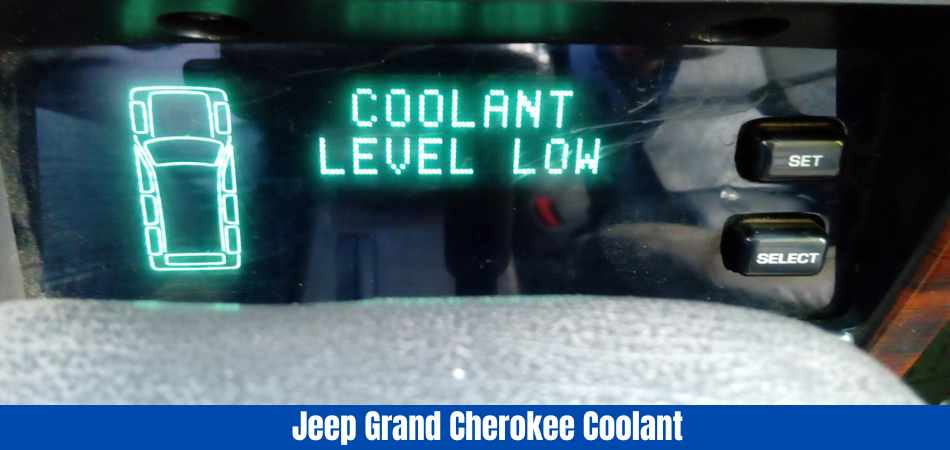
Compared to older coolants, newer ones use Organic Acid Technology (OAT). These long-life coolants can last up to five years or 100,000 miles in some cases.
Useful Tips For Coolant Change on Jeep Grand Cherokee
Even coolant has quirks and features that are worth knowing. Being knowledgeable about it also protects you and your Jeep Grand Cherokee from any harm.
Checking or replacing coolant when the engine is hot is not a good idea! You may be burned by the unexpected overflow. In addition, when it is hot, the level expands and shows the incorrect information.
Both the Jeep Grand Cherokee and the coolant will benefit from a periodic flush and change, as necessary.
If the coolant level decreases before the specified period, take the car in for a thorough inspection; there could be a leak.
It is highly recommended to use a coolant recommended by the manufacturer. A coolant may have different components in its structure that are good for some Jeep vehicles but not for others.
In addition to cooling, coolant protects your Jeep Grand Cherokee’s engine from corrosion and scale. Therefore, it is crucial to check the liquid level inside the reservoir and to fill it if necessary. Over time, your vehicle’s engine will be greatly improved.
Conclusion: Jeep Grand Cherokee Coolant
It is important to check and replace the coolant in your Jeep Grand Cherokee. Your car’s engine will not overheat, corrosion will not occur, and other problems will not happen.
The process of replacing coolant is simple. However, it takes time, patience, and a sequence of steps. It may be advisable for you to seek the help of an experienced mechanic at the repair shop if you need more time to make it.
Read more of our articles here.
Read also: Jeep Grand Cherokee Models, Generations & Redesigns
FAQs
What coolant do I put in my Jeep Grand Cherokee?
In order to perform a complete fill, top off, or a flush/fill, you can use PEAK ORIGINAL EQUIPMENT TECHNOLOGY 50/50 PREDILUTED ANTIFREEZE + COOLANT.
Does it matter what coolant I put in my Jeep?
Jeep, like many other vehicle manufacturers, has developed its own coolant or uses a coolant that is specific to the model and year of the vehicle. So yes, it does matter.
Can you mix coolant colors?
There are some people who do not mind it, as long as it matches the coolant already in the system. Experts, however, advise against mixing colors of coolants.
How do I choose the right coolant?
If you are not sure what type of antifreeze your vehicle requires, check its owner’s manual.
How do I know if my Jeep needs coolant?
You can check your coolant levels by looking at the reservoir’s side. The side of the reservoir will have markings, and you will be able to see the coolant level through it.
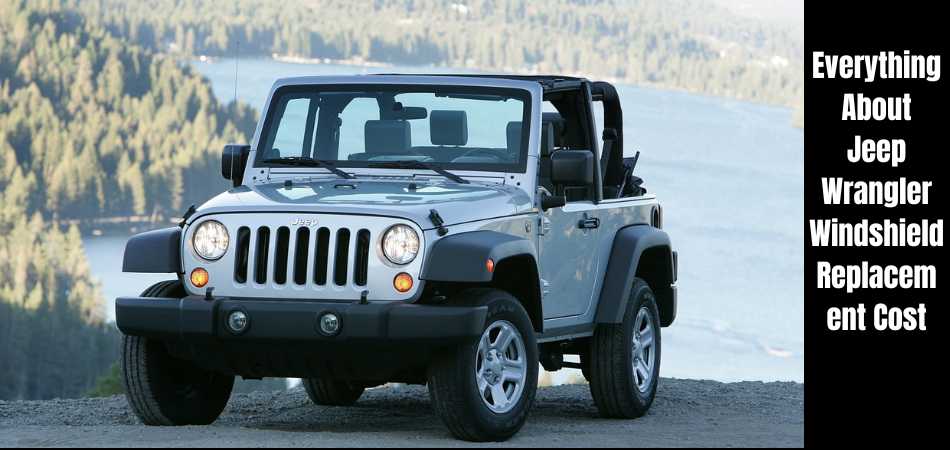
In comparison to any other vehicle, owning a Jeep is an experience like no other. The lifestyle, the community, the “go anywhere, do anything” attitude – owning a Jeep is more than just getting from point A to point B. But what about the Jeep Wrangler Windshield Replacement Cost?
If Wrangler and Gladiator owners love a lot of things about their Jeeps, but there’s one thing that consistently keeps them off the road (and not in a good way) – cracked windshields.
As a Jeep owner for quite some time, we bet you have experienced more than your fair share of broken windshields.
Owners of Wranglers and Gladiators are more likely to have to replace or repair their windshields regularly – sometimes more than once a year. What’s the point? Is it worth replacing, and if so, how much? You don’t have to worry – we have answers!
Why Do Jeep Wrangler Windshields Break Easily?
Considering the frequency with which we see this issue, we wondered…are Jeeps prone to cracked windshields? Why Do Jeep Wrangler Windshields Break Easily?
It turns out the answer is pretty straightforward. It was one of the original goals of the Wrangler windshield to produce something that could be manufactured inexpensively and easily replaced. Due to this, we have the flat, vertical windshield we are familiar with.
Any windshield with a flat, vertical surface attracts rock chips. The windshield will get hit head-on by any rocks kicked up when it is more upright. If a rock hits an angled windshield, it is more likely to bounce off and exert less force on the glass, reducing the likelihood of it breaking.
In addition, if you’re out there living the jeep life, your tires may be more off-road than on, so your windshield is even more likely to take some nasty rock chips.
Having a Wrangler or Gladiator windshield with a susceptible windshield orientation and off-road shenanigans will pretty much guarantee you lifetime membership in the cracked windshield club.
When Should You Replace Jeep Wrangler Windshield?
The risk of being ejected from your car during a collision increases if your windshield is not repaired early. Knowing When Should You Replace Jeep Wrangler Windshield is important. Catching it early is especially important for your safety.
This increases your chances of dying. Additionally, your insurance company may not cover overall damages down to the windshield. If left alone, the cracks will continue to grow until replacement is the only option.
To catch this early, what are some of the best signs? The first thing to check is whether your glass is tempered. You have strengthened and reinforced your windshield glass through this process. The first impression may be that this is a positive development. As a result, if a collision occurs, the glass will shatter and fall to the ground or into your face. Collisions are more likely to result in fatalities when this is the case.
You should replace this with laminated glass instead. A layer of plastic is heated between thin sheets of glass and adheres to them as lamination sheets do. A collision will cause the broken glass to stick to the second layer of glass.
Consequently, there is less chance of the driver getting cut by broken glass. Laminated glass is much safer than unlaminated glass for your windshield because it keeps you safer.
There will be more cracks appearing, which increases the chances of something breaking the whole thing. As a result, your insurance company may decrease the amount of coverage you receive.
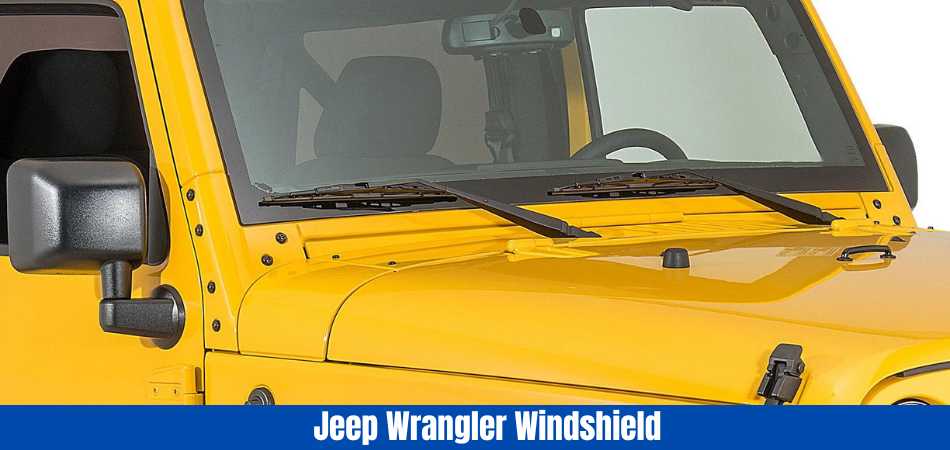
Even though it may be annoying to pay the money upfront when the crack is small, you end up saving more money in the end. Besides chipping and pitting, other signs can occur. If left unattended, something as small as a rock chip can grow into something much worse.
Jeep Wrangler Windshield Replacement Cost
It’s likely you’re here because your windshield already has a crack, and learning why it’s broken is not as useful as knowing what to do. “How much is the Jeep Wrangler Windshield Replacement Cost?” is probably one of your first questions.
There are a few factors that affect the cost of repairing or replacing your windshield:
- Your Jeep’s year of manufacture
- It depends on the trim level and whether you have any advanced driver assistance systems behind the windshield.
- Replacement glass type (OEM, OEE, or aftermarket)
Older Jeeps tend to have lower replacement costs since there are usually more replacement parts available (generally). A newer vehicle is more likely to have advanced technology behind the windshield, such as Adaptive Cruise Control (ACC) and Forward Collision Warning (FCW). Although these features are awesome, you’ll have to recalibrate them when you replace your windshield, which can be a pretty expensive process. Jeeps aren’t the only ones affected! The cost of windshield replacement has risen skyrocketed lately, as we wrote about in a whole post.
Here’s an example of the difference between a 2015 Wrangler windshield and a 2021 Wrangler windshield based on Safelite’s online quote calculator tool.
We found the following:
Cost By Jeep Wrangler All Years:
2021 windshield replacement cost: On average, the cost ranges from $400 to $950.
2020 windshield replacement cost: This may range from $400 to $900, depending on the location and quality of materials used.
2019 windshield replacement cost: The cost can range from $300 to $900, and may be covered by insurance.
2018 windshield replacement cost: Cost may vary, but on average ranges from $300 to $850.
2016 windshield replacement cost: On average, the cost ranges from $300 to $800.
2015 windshield replacement cost: It can range from $300 to $800, depending on location and quality of materials.
2014 windshield replacement cost: Replacing the windshield on a 2014 Jeep Wrangler can range from $240 to $600.
2013 windshield replacement cost: Cost may vary but ranges from $200 to $700 on average.
2012 windshield replacement cost: The cost can range from 200 to $700, and may be covered by insurance.
2011 windshield replacement cost: On average, the cost can range from 200 to $700.
It depends a little bit on where you live and where you can find a glass repair or replacement shop. This should give you a general idea of what you can expect to pay, but we recommend contacting a local contractor if you need an accurate estimate.
Choosing an OEM part over an aftermarket part is generally going to cost considerably more than choosing an aftermarket one.
What are the Factors Affecting Jeep Wrangler Windshield Replacement Cost?
Cars have a wide range of characteristics, and the windshield replacement costs of are also very different. As part of the windshield of modern cars, there are various safety and technological features such as Blind Spot Monitoring, Lane Departure Warning, Automatic Emergency Braking, etc. During the replacement of your windshield, it is likely that these sensors will also need to be replaced and calibrated.
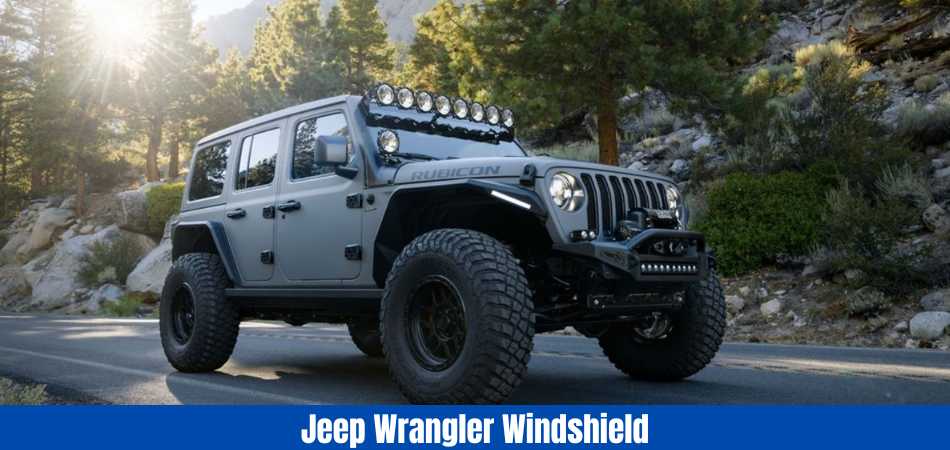
The replacement of a windshield becomes more complicated with the development of new and advanced technology. Therefore, windshield replacement costs are higher on more recent models. Among the other factors that determine the windshield replacement cost are:
1. OEM vs. Aftermarket Windshield:
You can restore your vehicle’s original factory condition by replacing the windshield with an OEM replacement. They are more cost-effective and more viable than aftermarket windshield replacements, which use cheaper materials.
2. Auto Shop Location:
The cost of replacing your windshield varies depending on where you live. In some cases, there are significant differences between states when it comes to this type of service. If you need an immediate windshield replacement after severe damage occurs while visiting a friend in another state, keep that in mind.
3. Windshield Replacement Appointment Type:
You can damage the windshield of your vehicle anywhere and anytime while driving. It is possible to have your windshield installed in a shop or on the go. Your choice of appointment determines the price difference.
4. Insurance Coverage:
A windshield replacement cost may also vary based on the type of insurance coverage and the damage to the windshield.
5. Windshield Type:
For extra security, you must pay extra for tinted or tempered windshields, as these options are generally more expensive.
OEM vs OEE vs Aftermarket Windshields: Which is Better for Jeep Wrangler?
When it comes time to replace your windshield, you probably already know that there are three options: OEM, OEE, or aftermarket.
It can be confusing to distinguish between all three, so here’s an explanation:
OEM: Original Equipment Manufacturer
As close a copy as you can get to your original windshield, OEM glass will have the same quality and features as the windshield that came off the assembly line. To maintain the integrity of these safety systems, many manufacturers recommend only replacing your windshield with OEM glass as the technology behind it gets more advanced.
We don’t know if FCA has mandated this for Jeeps yet, but other OEMs such as Honda and Mercedes-Benz have.
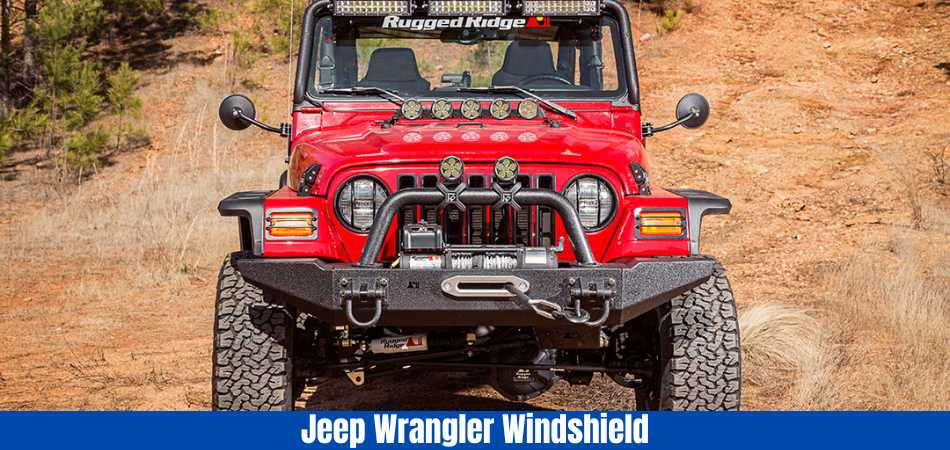
Also, if you replace your windshield with OEM glass, you keep your Jeep logo and that little easter egg (if you know what I mean).
If you need to replace your Wrangler windshield on a regular basis, it’s worth considering the cost of an OEM glass replacement over an aftermarket one.
OEE: Original Equipment Equivalent
OEM glass is an aftermarket windshield made to the exact specifications of OEM glass (albeit without the logos and decals you may be familiar with).
Compared to OEM glass, it may have a slight difference in thickness and clarity according to most auto glass specialists. Due to its low cost, OEE glass is often preferred by many people to replace their windshield.
It may be a good idea to use OEE glass if you’re looking for a cost-effective yet reliable option.
Aftermarket Windshields
These aftermarket windshields are made by a manufacturer other than the OEM, but they are cut to fit your vehicle. There is a wide range of quality between aftermarket glass, with some being quite good copies of the original and others being noticeably worse (fit, clarity, thickness – you name it).
Aftermarket windshields may even be more likely to break than your original windshield if their thickness is compromised. With so many aftermarket windshield manufacturers out there, it’s difficult to say whether this is a good idea. Before taking the risk, we recommend consulting an expert or someone who has tried the aftermarket glass you are considering.
Moreover, we recommend doing your research if you are planning to replace the original glass with an aftermarket one (EXOShield is all about safety!).
The choice is ultimately yours! There are plenty of Jeep owners who are completely satisfied with their aftermarket glass, according to Jeep forums. Although some people swear by OEM windshields, others are willing to pay a little more for peace of mind. Based on your driving habits and cost differences, choose the option that makes the most sense for you.
If you’re trying to decide between OEM and aftermarket glass, here’s a resource you might find helpful!
Is It Better To Repair Or Replace A Jeep Wrangler Windshield?
Jeep windshield replacement involves more than just the work – it involves the cost as well. It is possible that repairing it would be more cost-effective than replacing it.
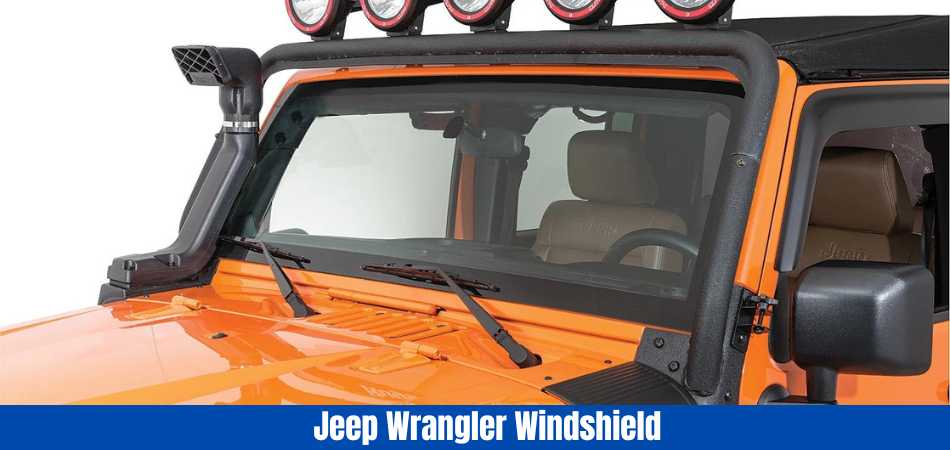
Depending on the type of damage involved, it is sometimes possible to repair a Jeep Wrangler windshield. You can fill a small chip or crack rather than replace your windshield, but only if you have a small one.
In most cases, car windshields become chipped or cracked when they are hit by an object. Before deciding whether to repair or replace the glass on your jeep, consider the following:
- The cost of replacing a Jeep windshield
- The possibility of repairing the damage
- Are there any distortions?
Your Jeep’s windshield is essential to its operation and safety, so it’s essential to get both repairs and replacements done properly.
How Do I Protect My Jeep Wrangler Windshield?
You should install a Jeep windshield sunshade in order to protect your Jeep’s windshield. By using a sunshade, you can protect your Jeep’s windshield from damage. The sunshade can also provide additional protection from UV rays and excessive heat if you have a soft top. Jeep windshield sunshades are easy to install and can be removed when not in use.
A sunshade will protect your Jeep windshield from UV rays that can damage it and cause cracks. As well as being lightweight, the sunshade can also be easily stored when not in use. Using a Jeep windshield sunshade also prevents the sun’s glare.
Conclusion: Jeep Wrangler Windshield Replacement Cost
If your windshield has a large crack, you should avoid driving. Rides like these are unsafe for you and for your passengers. Furthermore, driving with a broken windshield is illegal.
If you get a nasty crack on your Jeep Wrangler’s windshield, you must replace it as soon as possible. A complete replacement may indeed be expensive, but it is better to be safe than sorry.
In the end, you will have to set aside $700-$800 to replace your Jeep Wrangler’s windshield. I sincerely hope this article will assist you in budgeting and understanding why prices differ.
Read More of our Articles here.
Read also: Five common causes of windscreen damage
FAQs
How much is the gorilla glass windshield for the Jeep Wrangler?
Gorilla Glass windshields are available now for the 2018 through 2021 Jeep Wrangler and Gladiator for $793 each.
Are jeeps known for cracked windshields?
Windshields on Jeep Wranglers & Gladiators are prone to chips and cracks, especially when driving on uneven terrain.
How do I protect my Jeep windshield?
It’s best to remove a layer of Windshield Defense every six months, but it can last longer depending on how much you use your Jeep® windshield.
What is the most durable windshield?
The glass in laminated windows is made up of two layers of glass sandwiched by a thin layer of vinyl. This makes the windows thicker, stronger, and safer.
What are Jeep windshields made of?
Corning Gorilla Glass Windshield. It’s the last thing you need to worry about. Ask for a Corning Gorilla Glass windshield next time it needs replacing.
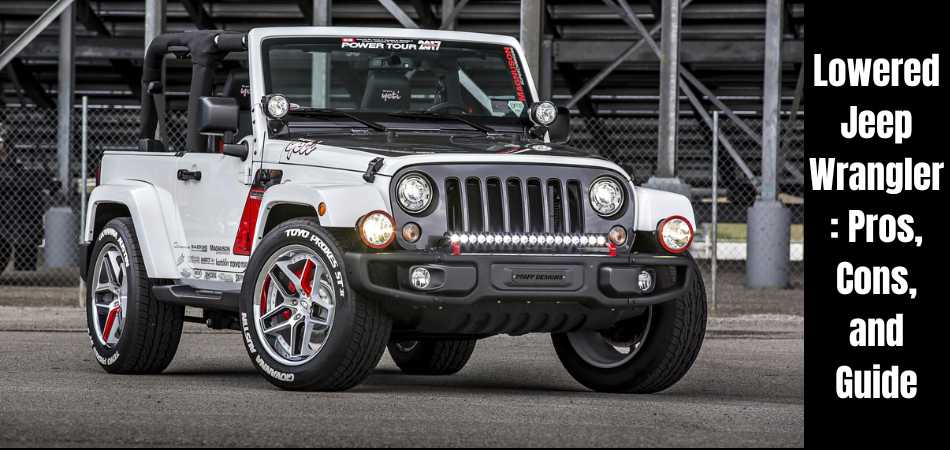
There has been no change in the Jeep Wrangler over the years. The straightforward styling, rigid performance criteria, and adaptability of its design have attracted a great deal of attention. Some owners, however, prefer Lowered Jeep Wrangler models because they no longer drive off-road
What is the best way to lower a Jeep Wrangler? It is possible to lower a Jeep Wrangler using coil springs, air suspension, and leaf springs. A lowering kit and shorter springs are other options. There is also the option of installing hydraulic systems, but this is an expensive option.
You should make your decision based on your desires and circumstances. If you want Lowered Jeep Wrangler, consider the strategies or actions mentioned above. If you have the necessary qualifications, you can complete the qualifications on your own.
So, let’s have a look at the step-by-step guide for Lowered Jeep Wrangler process.
What are the Advantages of Lowering a Jeep Wrangler?
1. With Lowered Jeep Wrangler, you can give it a more road-oriented feel. When you lower it with coil spacers or coil lowering shackles, the ride height won’t change as much as it does with a suspension kit.
2. Jeep Wranglers with lowered suspensions can also corner more effectively. A lower center of gravity will make your Wrangler more stable and easier to control in turns.
3. The third benefit of lowering a Jeep is that it improves the vehicle’s handling. You’ll be less likely to roll over your Jeep in difficult terrain or on the track if it has a lower stance. You will also be able to make tight turns more easily.
4. The fourth reason is that many people prefer lowered Wranglers to those that are not lowered. Lowering your Wrangler is a good way to give it a more aggressive appearance, of course.
5. Last but not least, lowering a Wrangler can also improve its traction. Off-road conditions will be easier to handle for your Jeep because of its lower center of gravity and more weight over the wheels. Wranglers can be especially vulnerable to damage when they are taken through challenging terrain.
What are the Disadvantages of Lowering a Jeep Wrangler?
You have many options when it comes to customizing a Jeep Wrangler. Before making this change, it is important to consider “What are the Disadvantages of Lowering a Jeep Wrangler?”
1. The lowered Jeep Wrangler can compromise its off-road capabilities, which is one of the main concerns. At high speeds, the lower stance can make it more difficult to navigate obstacles, and it can also affect the vehicle’s stability.
2. Furthermore, lowering the suspension will change how the factory ride feels and tastes. There may be a rougher, less comfortable ride, and it may not be suitable for long road trips as before.
3. Those who lower the suspension of their Jeep Wrangler may also encounter warranty restrictions. Dealers may refuse to honor warranties if they determine that modifications were made purposefully to void them.
4. As a final note, lowering a Jeep Wrangler can be an expensive process. In addition to replacing the springs and shocks, you may have to purchase new fender flares to cover the exposed wheel wells.
Steps To Lower Your Jeep Wrangler
Most mechanics recommend five steps or methods for reducing the ride height of your Wrangler. The following are among them:
1. Shorten the spring
Jeep Wrangler springs are located between the frame and wheels, like those on most cars. As part of your car’s suspension system, it maintains your car’s set height and permits movement.
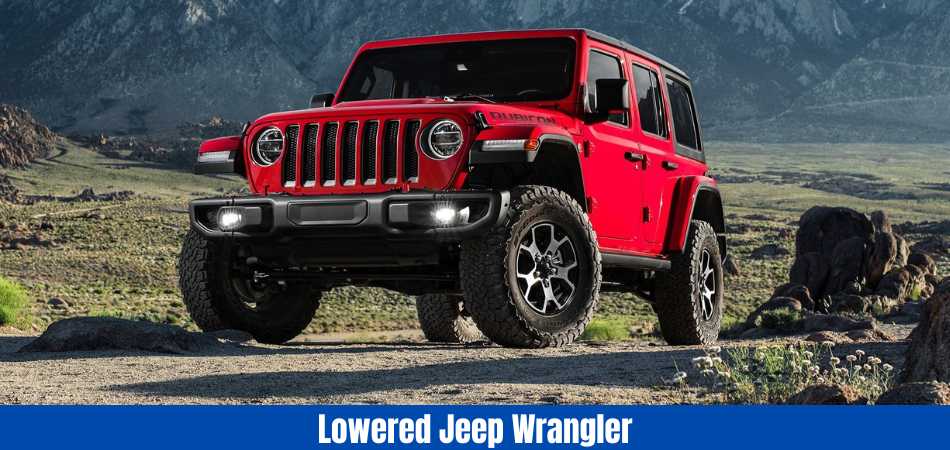
The easiest and safest way to lower your vehicle is to replace the spring with a shorter one. The Jeep Wrangler lasts a long time, so it’s likely you’re going to modify an old model anyway, requiring part replacement.
The following options are available to you:
Short spring
A shorter spring can be purchased from several auto-part shops or suppliers that are compatible with your Wrangler’s suspension system. This includes both online and offline retail stores.
You can adjust the spring length if you don’t want to spend money on a new spring or if the original spring hasn’t worn down yet. Depending on the type of spring your Wrangler has, there are several ways to do it.
Leaf Spring
To shorten the length of older models, you can remove the leaf springs and have them de-arched at a mechanic’s shop.
Installing a flip kit will also move the axle from under the spring to the top, reversing the setup. You can do this yourself or hire someone with the right tools and skills to do it for you.
It is also necessary for the auto mechanic to install a lowering block after installing the flip kit. If you want to lower your Wrangler to its lowest possible height, this is the best option.
It may also be necessary to purchase a C-notch that the mechanic will place above the rear axle of your vehicle. By doing so, you will ensure that the axle and frame have sufficient clearance.
As a result, there are flip kits available that already have C-notchs, such as the Belltech 6850 Flip Kit (view on Amazon).
Coil Spring
If Wranglers with coil springs rather than leaf springs can be adjusted by removing the coil spring. In the following step, you can either have the coil springs shortened and softened by a coil spring specialist or use a cutting wheel, torch, hacksaw, or grinder to precisely cut them in equal lengths.
It is important to remember that unequal lengths will result in uneven and unstable rides if your car is not level. If you need a longer coil spring for your Jeep, first cut them in half and then cut them in smaller increments.
The DIY cutting method may be more practical, but it can damage or weaken coil springs. In particular, if you are not skilled enough to handle the tools and perform DIY mechanical tasks.
2. Changing or adjusting the control arm and track bar
Keeping the axles of the Wrangler from moving sideways is the job of track bars when it comes to coil spring suspension systems. A track bar is not adjustable on some units, but one is adjustable on others.
The track bars on your car are adjustable, so use a small wrench to lower each one to an acceptable height. Instead, if you have ones that are not adjustable, you should have them replaced with shorter ones.
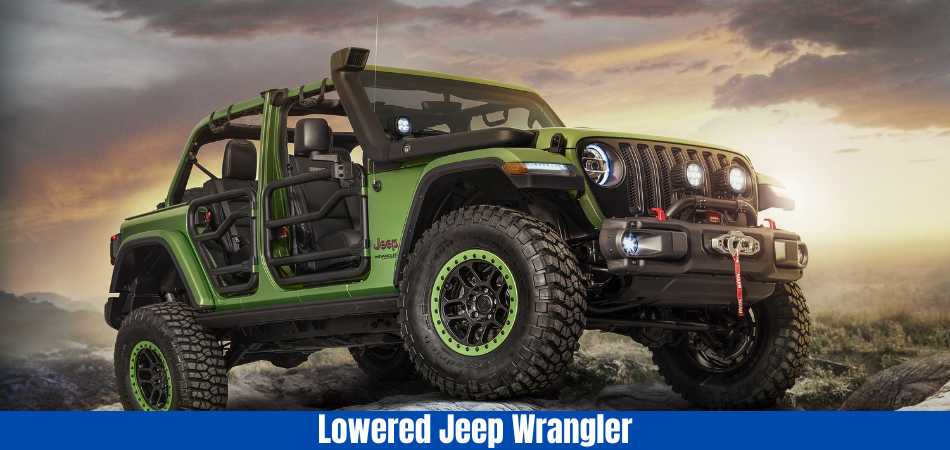
Your unit’s control arms also need to be replaced. As a matter of fact, this is best combined with the replacement of coil springs or adjusting their length.
3. Get a lowering kit installed
If When you want to lower your Jeep Wrangler without the hassle of adjusting the coil spring and trail bar, you should consider purchasing a Jeep Wrangler Lowering Kit.
There are already several brands offering these kits, so finding one should not be a problem. You should keep in mind that each kit will contain different components. Therefore, choose one with everything your Wrangler needs to be lowered safely and properly.
It won’t matter whether you make a mistake or if the part is incompatible. Most of the following parts are included in these kits (sometimes more):
- Springs (leaf or coil)
- Brackets
- Arms
- Shocks
- Stabilizing bars
For your peace of mind, some kits will include instructions, while others will be backed by a manufacturer’s warranty. A Jeep Wrangler Lowering Kit is also easy to install, either by yourself or by a professional.
It may be worth considering the Belltech 614 Lowering Kit (view on Amazon) if you are planning to go this route. In addition, it includes all the necessary alignment and installation materials. Depending on the type of shock your car needs, you can choose between a Nitro Drop or Street Performance kit.
4. Invest in an air suspension system
Is it true that you don’t really need to permanently lower your Jeep Wrangler? The airbag suspension system is responsible for all of that!
By Installing one allows you to customize the ride height of your Jeep Wrangler to suit your specific needs. Lift it when driving on rough terrain or carrying heavy cargo, and lower it when driving on smooth surfaces.
Coil Springs –
In this method, you would remove your car’s coil springs and shocks and replace them with an airbag unit. Additionally, you would need an air compressor, air lines, a tank for storing air, and an activation switch. In spite of this, you don’t need any special tools or equipment to complete this project.
Leaf Springs –
If It is necessary let a professional fabricator replace the leaf springs on your Jeep Wrangler. By replacing the leaf springs with four-link springs.
5. Hydraulics Installation
Installing a hydraulic system allows you to adjust the ride height of your Jeep Wrangler similarly to an air suspension system. Instead of using air, this uses a fluid pressure system. The cost of this is far higher than an air suspension system; even maintenance would be costly.
If you choose this option, you can replace your car’s suspension coils with hydraulic cylinders on one, some, or all corners. It would also be necessary to install hydraulic pumps, an internal control system, and batteries in order to run the pumps.
As a result, this system will work more quickly than an air suspension. The only downside is that it will consume a large amount of battery power.
What are the Common Problems If Improperly Lowered Jeep Wrangler?
If you lower your Jeep Wrangler improperly, you could encounter some common problems. These are the issues we need to address:
1. An improperly aligned suspension:
Lowering your Jeep Wrangler without addressing suspension alignment can lead to a variety of problems. An improper alignment can lead to a vehicle pulling to one side or feeling unstable.
Furthermore, it can lead to uneven tire wear, reducing the lifespan of your tires and negatively affecting the handling of your vehicle.
In order to avoid this problem, you should have your Jeep Wrangler’s suspension alignment checked and adjusted after lowering. Having all suspension components aligned properly ensures optimal handling characteristics and proper alignment of the suspension components.
2. COG and Roll Center are inaccurate:
Lowering your Jeep Wrangler can change the vehicle’s center of gravity and roll center, affecting its stability during off-road maneuvers and cornering. Excessive body roll can compromise the vehicle’s handling and safety if the roll center is misaligned.
Modifications that maintain the correct roll center and center of gravity are important when lowering your Jeep Wrangler. A suspension geometry adjustment may require the installation of adjustable control arms, sway bars, and other components.
3. Drivetrain angle incorrect:
When you lower your Jeep Wrangler without correctly addressing the drivetrain angle, driveline vibrations, premature wear, and potential driveline failure can occur. A change in ride height can put additional strain on the drivetrain, resulting in these problems.
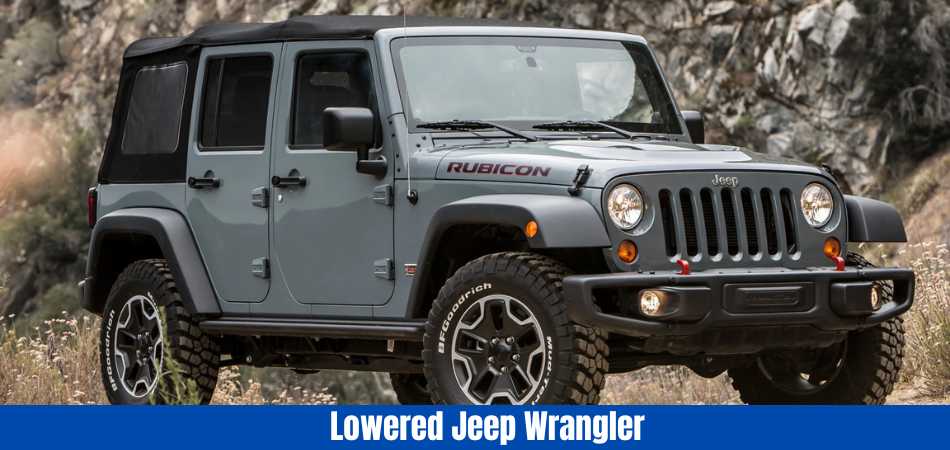
It’s essential to adjust the drivetrain angle after lowering to avoid drivetrain problems. A driveline spacer may be installed, adjustable control arms could be installed, or the transfer case or axle components could be modified.
The best approach for maintaining the correct drivetrain angle can be determined by consulting with experts who specialize in Jeep Wrangler modifications.
Before lowering your Jeep Wrangler, it is essential to understand these potential problems. The next step is to explore the step-by-step process for achieving the desired lowered look.
How Much does it Take to Lower a Jeep Wrangler?
The process of lowering a Jeep Wrangler can be a fun and relatively inexpensive way to customize your vehicle. Before you start lowering your Jeep, you should consider that, how much does it take to Lower a Jeep Wrangler
It depends on the type of kit, the size of the lift, the installation fee, and how much it costs to lower a Jeep Wrangler. The cost of a complete kit can range from $200 to $1,000. Most kits include all the necessary parts and instructions for installing a smaller lift, which is typically less expensive than a larger lift.
Alternatively, you can hire a professional to install the kit for you if you’re uncomfortable doing it yourself. Although it will increase the overall cost, it may be worth it if you are not confident in your abilities. You should expect to pay between $100 and $200 for a professional installation.
In order to compensate for the new height of your jeep, you will need to adjust your suspension and brakes. The task can be challenging, but with a little basic knowledge and some tools, it can be accomplished.
It may also be necessary to re-align the steering wheel in order to ensure straight driving.
The overall process of lowering a Jeep Wrangler is relatively easy and affordable. Before you start, make sure you consider all the costs involved.
What is the Difference between Lowering by Yourself or by a Mechanic?
Whether you decide to lower your jeep yourself or hire a mechanic, it can be a rewarding experience. But, what is the difference between lowering by Yourself or by a Mechanic? You can take on the challenge and complete the project yourself, but a mechanic can make sure that everything is done correctly and precisely.
You can do it yourself or hire a professional, but the main differences are cost, knowledge, and resources. In order to repair the problem yourself, you may need to acquire the necessary parts first. You may also have to do some research and experiment to figure out how to install them.
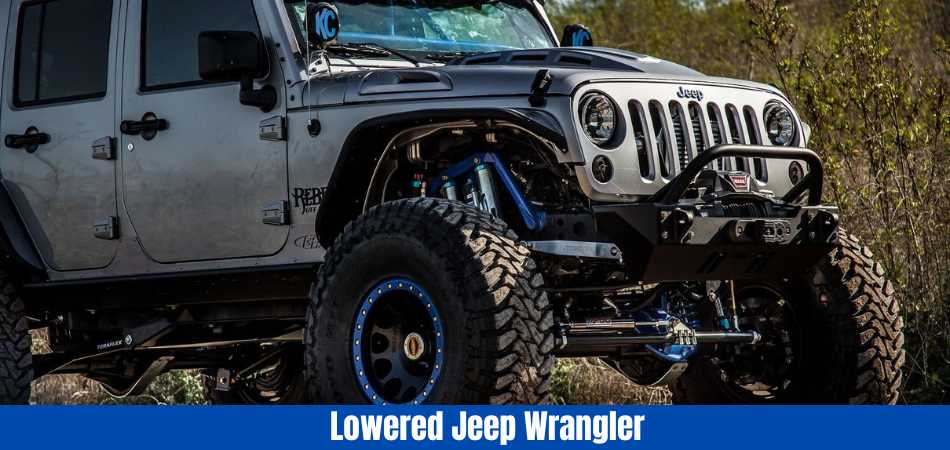
A mechanic, on the other hand, will likely have direct access to parts and extensive working knowledge when it comes to repairs and modifications, which will save you time.
Precautions While Lowering the Jeep Wrangler
To avoid damaging your Jeep Wrangler when lowering it, you should take some precautions. Before lowering the car, make sure the suspension has been adjusted properly.
You should also be careful when driving on uneven surfaces, as this can make your Jeep unstable. Moreover, you should avoid hitting potholes or bumps while lowering the car because this can damage the suspension.
Finally, when working on the suspension of the car, make sure to use a jack and stand to prevent injuries. These guidelines will assist you in safely lowering your Jeep Wrangler and preventing damage.
Conclusion: Lowered Jeep Wrangler
The Jeep Wrangler is an enjoyable vehicle to drive. Also, users are using Lowered Jeep Wrangler on the street. Taking a Jeep Wrangler to a lower height may change your way of riding on the freeway.
Nevertheless, you must acknowledge its shortcomings and find a solution that works for you. We’ve hopefully covered every aspect of lowering a Jeep Wrangler in this post.
As long as you take a few precautions, it’s easy to do. If you frequently drive off-road, it is not recommended to lower the Jeep Wrangler.
Read more of our articles here.
Read also: 2024 Jeep Wrangler
FAQs
1. How much is it to lower a Jeep?
A simpler system costs around $400, while a more sophisticated one can cost more than $1,000.
2. Is there a smaller version of the Jeep Wrangler?
It is the two-door Jeep Wrangler that is the smallest Jeep Wrangler model. In terms of dimensions, the most recent model year (2021) measures 166.8 inches (4,237 mm) wide and 73.8 inches (1,875 mm) long.
3. Is lowered suspension good?
The aerodynamics of low-riding vehicles are better. There is less air hitting the wheels and tires (that aren’t streamlined). As a result, these cars are faster.
4. How do I lower my suspension?
A bracket called a shackle connects the rear mount to the leaf spring. A longer or shorter shackle can lower a leaf spring suspension, depending on how they are arranged
5. Do lower cars ride rough?
A lowering spring with a high spring rate, on the other hand, creates a rough ride that can lead to bump steer and other dangerous and unpredictable conditions.
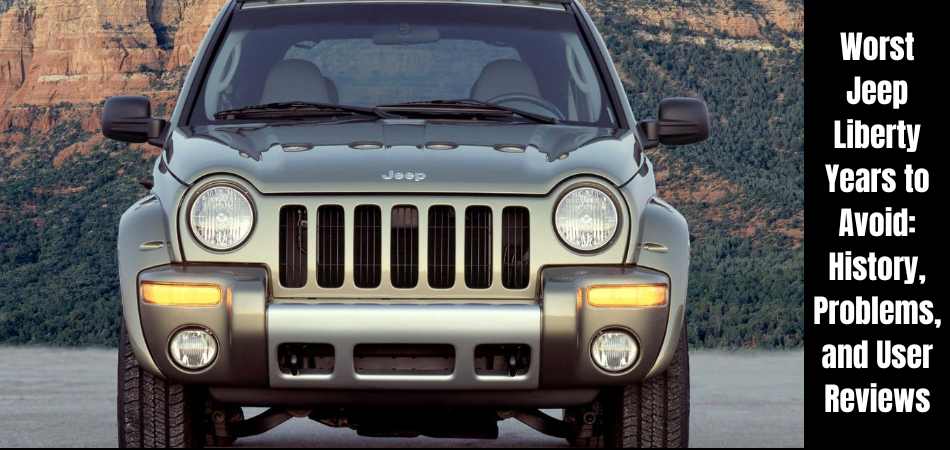
Jeep is among the most recognizable and well-known brands worldwide. Renowned for its exceptional amphibious qualities, the five-seater Liberty debuted as the subsequent small SUV in an extensive series of well-received cars in 2002. Until 2012, when it was formally phased out, they kept making this model with minor redesigns and improvements. However, if you want the best performance car, there are some Jeep Liberty years to avoid.
Because of the distinct features that set it apart from rivals, most drivers refer to the Jeep Liberty as an amphibian in automobiles. It was the first Jeep with a rack, pinion steering system, and then-new PowerTech engines. Its above-average dependability and comfortable interior make it stick in drivers’ minds.
So, which Jeep Liberty years should you avoid? Why should you stay away from them? Why do they live a shorter life than most? Well, read the article to learn more about it.
What are the Most Common Jeep Liberty Problems?
The Jeep Liberty is a highly competent little SUV prepared to meet your demands and provide you with the best off-roading experience that Jeep is renowned for. But What are the Most Common Jeep Liberty Problems? Knowing what issues your car is prone to helps you enjoy it more since you’ll be able to prevent them or at least have a good notion of what to do when they arise. The most frequent issues with Jeep Liberty that you should be aware of are listed below.
1. Defective TIPM
With fuses and a computer, the integrated power module controls how power is distributed throughout a car. The 2011 and 2012 Jeep Liberty vehicles are primarily affected by this issue.
Automobile owners have reported zero gauges, and all warning lights are on. This issue prevented the drivers from starting the car in certain extreme situations.
Because the engine control unit (ECU) and TIPM are interchangeable in Jeep vehicles, you should not purchase a Liberty that exhibits indications of a malfunctioning ECU.
2. Faulty sky slider sunroof
Liberty distinguished itself from rivals with an unmatched panoramic vista from its Sky Slider sunroof. But the sunroof came with too much sun, a failing material, and wind noise.
The 2008–2010 Liberty models were the most plagued by this problem, to the extent that clogged drain tubes frequently caused water to spill into the inside.
To address this issue, drivers filed a class action lawsuit in 2014, alleging that Chrysler failed to provide drivers with the required maintenance information, causing interior damage. Chrysler was ordered to pay $129,000 for repairs and $350,000 in legal fees.
3. Faulty power door locks
Due to its misbehaviour, several drivers have had to replace the door lock actuator, costing up to $200. Whether or not this is a manufacturing issue is unclear.
4. Fluid leaks
Wear on the differential pinion or transfer case seal can result in fluid leaks in Jeep Liberty models manufactured between 2002 and 2012. One crucial reason why bearings fail is leakage. Furthermore, one of the primary indicators of a poor transfer case that could result in shifting problems is leakage.
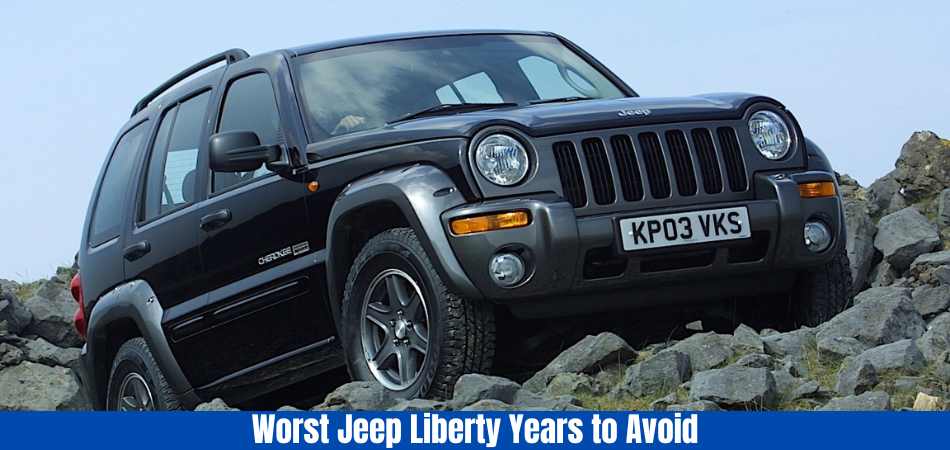
5. Ineffective window regulators
The Jeep Liberty models from 2006 and 2007 received the highest complaints regarding this problem. The defective component would click while rolling down the windows and become lodged in the door latch, making it impossible for the door to open.
To exacerbate the situation, several drivers report that the issue still exists even after numerous regulator replacements. Many drivers steer clear of the 2006 and 2007 versions to save up to $200 on window regulator replacements every time.
In 2010, drivers filed a federal class action lawsuit against Chrysler due to the quantity and kind of the issue. Despite the case’s failure, it was evident that the windows posed a threat.
6. Faulty transmission
A faulty synchronizer assembly afflicted Liberty vehicles between 2002 and 2010, allowing the vehicle to burst out of first gear while accelerating. It can result in surging, poor fuel economy, stalling, hesitation, loss of power, and a start condition if it remains unchecked for an extended period.
Furthermore, a few motorists reported that their automatic Liberty models from 2003, 2006, and 2010 remained stuck in a single gear, preventing them from evaluating other settings except the default one. Reprogramming the powertrain control module solves this issue more quickly than the other prevalent transmission issues.
7. Engine Issues
Engine misfires are a typical problem with all Liberty models. There have been reports of engine knocks, excessive vibration during gear changes, and rough idling in more severe situations. A lousy intake valve is frequently the root of the issue.
Before the engine deteriorates to the point where significant repairs or replacements are required, you must take care of this issue. The intake valve replacement should cost, at most, $40 plus labor.
But if you drive a 2002 Jeep Liberty, things might go south for you. Engine failure is the model’s most common occurrence, especially after 100,000 km. This model irritated a lot of drivers because it occasionally cost more to replace the engine than the car itself.
8. Brake Issues
Specific Jeep Liberty models, particularly the 2004 model, have brake problems. There have been incidents where drivers had to shift into reverse to get moving because the front brakes locked up.
Even with replacing the brake calipers, brake pads, and master cylinders, many drivers have been unable to fix this issue. Remarkably, no recall has been issued for this issue.
3 Worst Jeep Liberty Years to Avoid
Jeep has different models or versions based on the respective year. There are, however, 3 worst Jeep Liberty years to avoid. Let’s have a look-
2002
Despite its popularity and cult following, the 2002 Jeep Liberty model year was the first to be avoided. It was the first year it was made available to the general public.
This is primarily because of problems with the airbag system, seat belts, and overall car safety rating. Not all airbags deployed during a collision, and the light occasionally switched on randomly.
Problems:
- Seatbelt recalls and airbags
- fluid seepage
- NHTSA safety ratings below average
In addition to numerous recalls and fuel leak issues, the 2002 model also experienced serious airbag difficulties. These caused fires, and the crash test results were below average, especially at the rear.
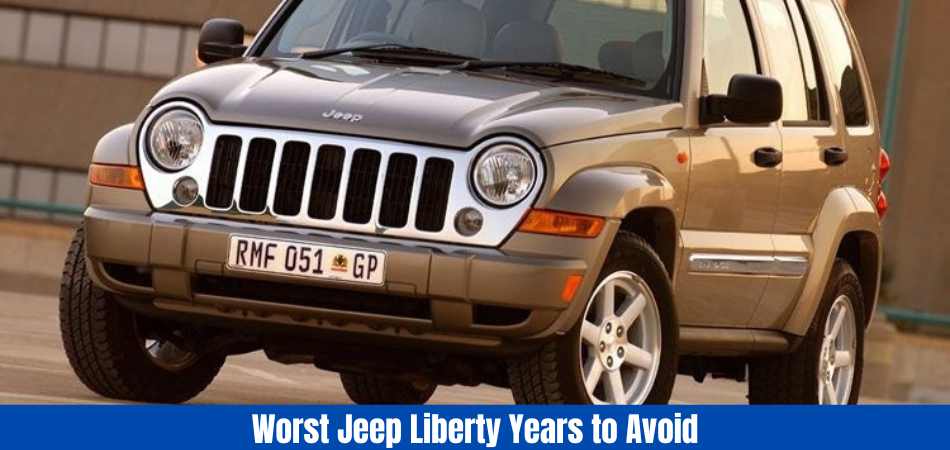
2004
The 2003 Jeep Liberty was more reliable than the 2002 model except for premature window failure and faulty ball joints. Regretfully, the 2004 model failed to maintain the trend and gained notoriety for its issues and recalls.
Problems:
- Faulty ball joints
- Failure of the power window
- Incorrect rear reflectors
The 2004 model had many of the same problems as the 2002 and 2003 models, and because parts were more challenging to come by, many of the recalls for the 2004 model were more expensive.
2012
Although it’s not the first thing that comes to mind when considering SUVs, particularly Jeeps, the 2012 Liberty’s fuel efficiency is far below average. The Liberty records as low as 18 miles per gallon in the city and 23 miles per gallon on the highway; other comparable SUVS average about 25 mpg in the city and 27 mpg on the interstate.
Regretfully, the 2012 Jeep Liberty was one of the poorest model years in the vehicle’s history and did not have a smooth exit. Many of the problems from earlier years persisted until Liberty was discontinued in 2012.
Consumer reports indicate that the ball joints and control arms are likely to break before 50,000 miles and that suspension problems from previous generations are still common. If the manufacturer’s warranty no longer covers the vehicle, these repairs could be costly and must be paid out of pocket after 50,000 miles.
Problems:
- fuel efficiency
- Hanging
- malfunctioning transmission
The 2012 model also had transmission issues, and a sharp decline in sales forced a replacement. The gears move slowly, and the automatic transmission is notorious for lagging and failing early. Furthermore, transmission fluid leaks must be replaced more regularly than in other cars to prevent premature component wear.
2012, the car’s crash test results improved, but there were still several safety concerns. The airbags failed to deploy in certain situations, and the light warning system was faulty.
Ironically, the Jeep Cherokee eventually replaced the Jeep Liberty, which was manufactured until the end of the 2012 model year. In general, the 2012 Jeep Liberty model year is one that you should stay away from.
What are the Best Jeep Liberty years to Choose From?
The Jeep Liberty is famous because it can easily handle most off-road conditions. Despite its intimidating exterior, this vehicle boasts a sumptuous interior with plenty of room for everyone. We’ve compiled a list of the most trustworthy options to make your decision easier.
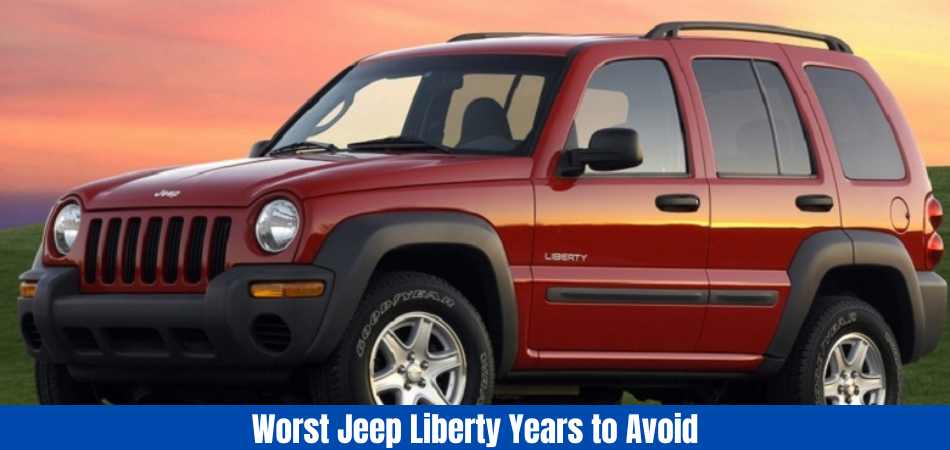
The following are the most dependable options now offered for the Jeep Liberty:
- 2009 Jeep Liberty
- 2010 Jeep Liberty
- 2011 Jeep Liberty
Choose one of these three Jeep models for your used automobile needs if you’re searching for the most dependable year the Jeep Liberty offers.
With the fewest customer complaints, these were the most significant years for the now-defunct Jeep Liberty. The renowned Jeep brand provides low ownership expenses and a great driving experience.
Selecting the Jeep Liberty option with the highest reliability level is best if you want to get the most out of your purchase. All of that, though, is meaningless if the Liberty model is faulty. How does it compare to other available competitors’ compact SUVs?
Why Was the Jeep Liberty Discontinued?
You can do better than the Jeep Liberty regarding dependability and all-around value. For the now-defunct SUV, things went south despite its rather promising start.
To name a few of its mechanical issues, the Jeep Liberty’s most common complaints included fluid leaks, illuminated check engine lights, and misfires brought on by malfunctioning intake valves.
The introduction of the Jeep Liberty represented the third generation of the Cherokee. It was dubbed “Liberty” to help people distinguish it from the Jeep Grand Cherokee. The five-passenger SUV was produced until 2012 when it was abruptly halted.
The Jeep Liberty was cancelled because it wasn’t the best seller the makers had anticipated it would be, just like everything else that met an unfortunate end. Although many Jeep fans loved the Liberty’s appearance—notably the second generation’s boxy redesign—it wasn’t enough to boost sales. It also had trouble satisfying many customers’ safety requirements.
Instead, the business resumed manufacturing the Jeep Cherokee, which is still in production today.
Is the Jeep Liberty Worth Buying in 2024?
Getting your hands on the more dependable Jeep Liberty models might be beneficial. The car can survive between 200,000 and 400,000 miles with the right upkeep and care.
There are, nevertheless, alternatives to the Jeep Liberty if you wish to make an automotive investment. Because of the high maintenance cost, drivers are more likely to focus on Jeep’s other, more dependable models.
What Should You Look for When Buying a Jeep Liberty?
Verify the amount of recalls the used Jeep Liberty has benefited from on the NHTSA website before purchasing. Additionally, determine how many issues the model should have and ensure it wasn’t created in 2002, 2004, or 2012.
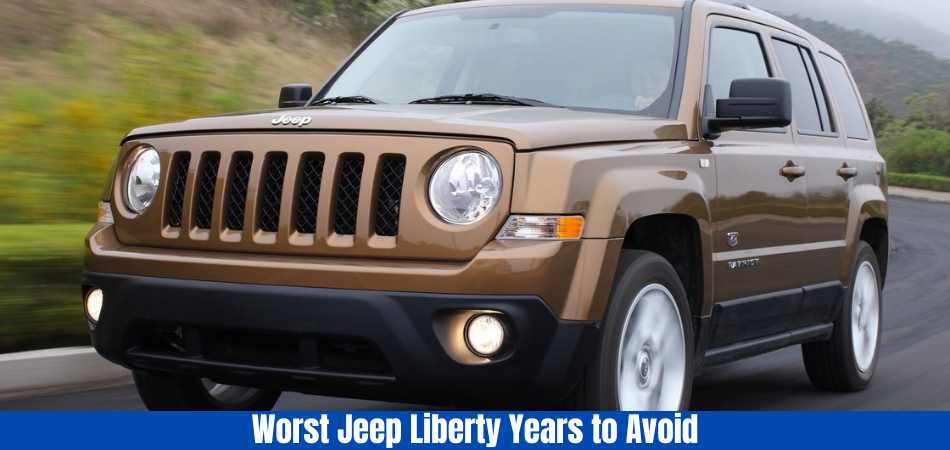
Is Maintenance for the Jeep Liberty Expensive?
The annual maintenance costs for a Jeep Liberty add up to approximately $700, making them relatively expensive. Its powerful engines and weight make it an excellent choice for off-track adventures and contribute to its hefty maintenance costs. They typically cost a lot to replace and repair when they break down.
Final Thoughts: Jeep Liberty Years to Avoid
In terms of dependability, the Jeep Liberty is a respectable option overall. For those who are enamoured with Jeeps and want a more economical option, it’s safe to drive even though there are some concerns to consider and better automobiles available.
We hope you find this helpful material! Choosing the most dependable vehicle can seem unattainable with tens of thousands of possibilities. We’re here to give you all the information to choose the vehicle you’ll be driving shortly.
Read more of our articles here.
Read Also: Jeep Liberty Models: What You Need to Know
FAQs
1. Why is the Jeep Liberty being phased out?
Cheers and Gears state that the decrease in Jeep Liberty sales was a significant factor in the model’s discontinuation. In addition, the customers’ expectations were not fulfilled by the safety ratings.
2. How long is the Jeep Liberty good for?
How the driver operates and maintains the vehicle directly affects how long the Jeep Liberty lasts, which determines how durable the car is. Nevertheless, the car can live more than ten to fifteen years.
3. Are there any transmission issues with the Jeep Liberty?
Transmission issues, such as a discernible delay between shifts or slippage between ratios, are common among drivers and Jeep Liberty owners.
4. Is maintenance for a Jeep Liberty expensive?
The average cost of maintenance and repairs for a Jeep Liberty is $674, so it is expensive to maintain. To resolve the issue with the Jeep Liberty, the owner will need to cover additional maintenance and repair costs.
5. Why does the petrol in my Jeep Liberty use up so much?
Fuel filter blockages cause the Jeep Liberty to use a lot of gas. A gasoline filter’s primary job is to rid the fuel of impurities and particles. This fuel filter becomes clogged over time and requires prompt maintenance.
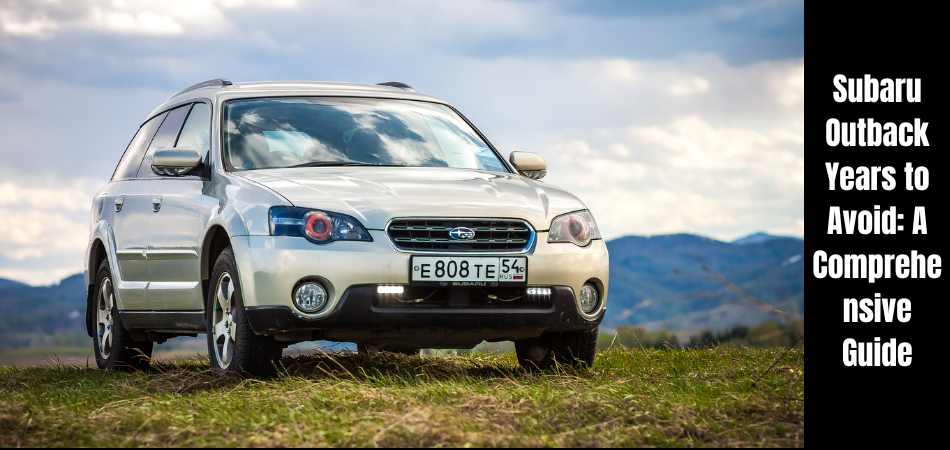
For decades, Subaru Outbacks have stood as symbols of adventure, versatility, and dependability. With its practicality and all-terrain capabilities, the Outback is a perfect combination of family car and off-road warrior. However, there are some Subaru Outback years to avoid that you must know before buying one.
The Outback is equipped with ample space for passengers and cargo, so everyone stays comfortable whether you’re on a road trip, exploring the great outdoors, or running errands. However, some model years were superior to others.
We’ll examine which Outback years were great and which Subaru Outback years to avoid.
Why Should You Avoid Certain Year Models of Subaru Outback
There were several factors contributing to the issues in these problematic years. Due to faulty piston rings, the 2011 model consumed excessive amounts of oil. A similar oil leak problem and transmission problems occurred on the 2013 model.
The 2014 model had issues with vibration during acceleration and low-quality brake pads. Batteries and windshields were persistent issues with the 2020 model.
Subaru Outback Generations & Their Reliability
1st Generation (1994-1999)
First introduced in 1994, the Subaru Outback was a rugged, all-wheel-drive wagon based on the Subaru Legacy. Despite its off-road capabilities and practicality, it quickly gained a reputation for setting the stage for future generations.
Its simplicity, reliability, and groundbreaking design still make it a favorite among enthusiasts.
2nd Generation (2000-2004)
Second-generation Outbacks feature improved performance and a refined design. During this generation, Subaru also introduced the Outback sedan.
The second-generation Outback maintained its reputation for reliability and all-terrain capability, even though it wasn’t as highly regarded as its predecessor.
3rd Generation (2005-2009)
With the third generation, design improvements focused on ride quality, handling, and safety. In addition to the more powerful engine, the Outback also gained better off-road capabilities.
In spite of the fact that the third generation was not as popular as the first generation, its performance and comfort were still highly praised.
4th Generation (2010-2014)
Outback’s fourth generation featured an updated exterior and interior and a more fuel-efficient engine. In contrast, several model years in this generation experienced recalls and engine issues, such as those in 2010-2011 and 2013.
It was still lauded for its improvements and updated features despite these setbacks.
5th Generation (2015-2019)
In addition to its more rugged appearance and increased interior space, the fifth-generation Outback featured numerous advanced safety features.
These models also experienced a number of recalls, as well as mechanical issues, especially in the 2017-2020 model years. There were legal issues relating to the 2019 model, especially due to a defective windshield.
6th Generation (2020-Present)
With significant exterior and interior updates and an upgraded infotainment system, Subaru Outbacks have demonstrated a strong return to form.
As well as offering a powerful yet fuel-efficient driving experience, the new turbocharged engine option is available. According to many, the 2021-2022 Outback models have a promising future.
Best Years For Subaru Outback
Here are some of the best models you can consider.
1. 2022 Subaru Outback (6th Generation)
A redesign of the 2020 Subaru Outback, the 2022 Subaru Outback boasts amazing features.
The top-notch interior features a lot of space, a silent cabin, and comfortable seats. Entry and exit are also effortless thanks to skillfully made doors.
With an upgraded suspension, more ground clearance, all-terrain tires, and other styling enhancements, the Outback belongs to the latest generation of SUVs.
Even though it doesn’t have the best fuel economy compared to its counterpart, the Legacy, it’s still okay. In addition to the 182-hp 2.5L engine, buyers can choose a 260-hp turbocharged 2.4L engine.
Towing smaller campers is also easy with this vehicle. Towing capacities for all Subaru Outback models can be found here.
2. 2020 Subaru Outback (6th Generation)
Subaru lovers will find this a great alternative with advanced and unique features. We all prioritize safety when shopping for a car, so most people like it because it has excellent safety features. The interior is spacious, and the fuel economy is decent.
This 2020 Outback is an excellent choice if you’re looking at the newer models, as it is quite versatile and offers excellent value.
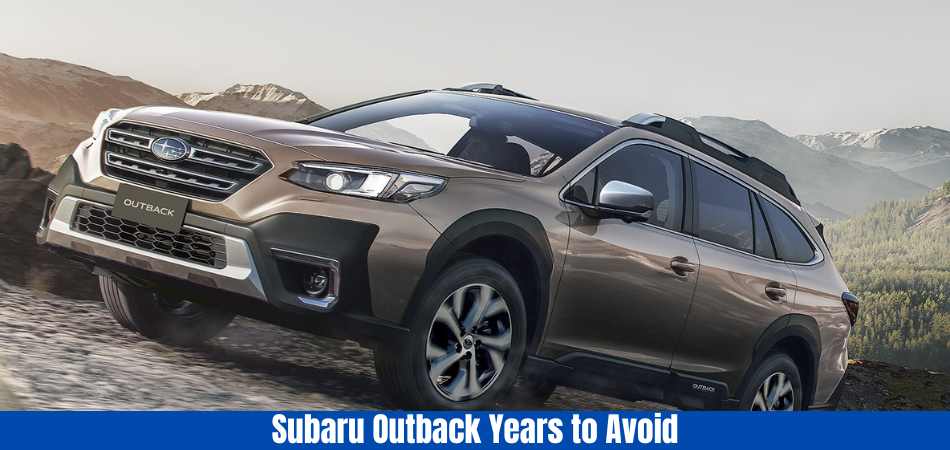
If you intend to drive in rough terrain, the Subaru Outback Premier XT and wilderness models offer the highest ground clearance.
3. 2017 Subaru Outback (5th Generation)
In our experience, the 2017 Subaru Outback is one of the safest and most reliable models. Among the top safety picks from the Insurance Institute for Highway Safety (IIHS), this model was recognized as a top pick. It received a five-star safety rating from the NHTSA.
Most car owners found this a practical and competent choice on the market. It also has a long life expectancy, exceeding 250,000 miles.
4. 2009 Subaru Outback (3rd Generation)
2009 was a significant improvement in consumer acceptance and love over previous years. In other generations, Subaru had many problems. Subaru fixed those issues.
Turbocharger XT, which produces 250 horsepower, was introduced. This model also has the advantage of lasting longer than other models.
5. 2005 Subaru Outback (3rd Generation)
The 2005 model is the last car on the list of best years. Engine changes improved the performance of the XT turbo engine.
A powerful 2.5L engine with 250 horsepower was the main attraction for most car owners. Nevertheless, it’s worth noting that this engine was obtained from a Subaru WRX STI, which produced more horsepower.
The vehicle’s general construction, including the panoramic sunroof, was another great feature. Enhancing the Outback’s aesthetics was the interior upgrade.
Last but not least, this vehicle was fuel-efficient and offered several safety features.
5 Subaru Outback Years To Avoid
Here are some Subaru Outback years to avoid. Check out our list of known Subaru Outback problems as well.
1. 2019 Subaru Outback (5th Generation)
Consumer complaints reached an all-time high in 2019. A considerable number of consumers, more than 816, expressed dissatisfaction.
The battery and windshield were the most common problems with this model.
Batteries are a significant concern since they are expensive to replace. Other than that, the windshield cracked randomly without being hit.
Many people started thinking the 2019 Outback wasn’t safe after this happened.
2. 2014 Subaru Outback (4th Generation)
This is the last model in the fourth generation, so you’d expect it to be one of the best. There were also several flaws with it.
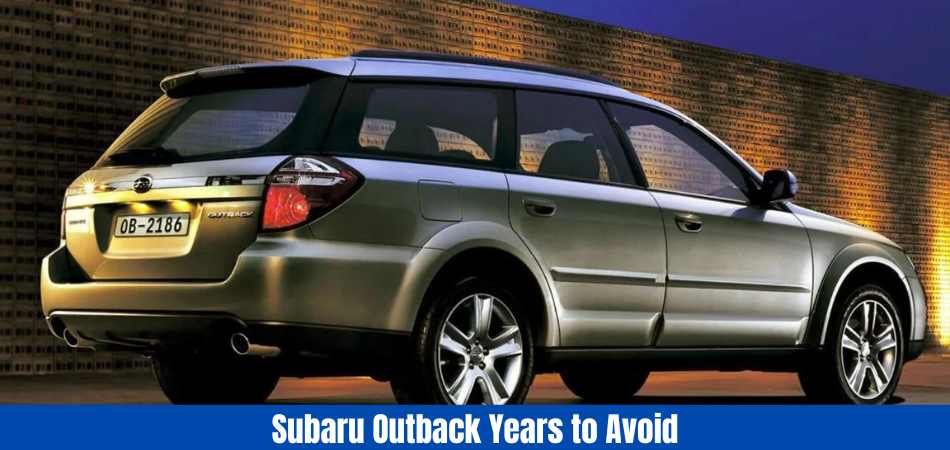
Vehicles had bad brake pads that wore out prematurely and hesitated when accelerating, as well.
3. 2013 Subaru Outback (4th Generation)
There may not be a worse model on our market than the 2003 Subaru Outback. Consumers and NHTSA both complained about many serious issues associated with it.
The main problem with this model was its excessive oil consumption. A defective piston ring could cause oil to flow into the combustion chamber, causing serious problems and making driving difficult.
Since the oil didn’t filter in the right place, carbon residues would form elsewhere. Owners of these cars had to replace their oil more frequently than usual, which cost them money.
Steering and transmission issues also plagued other customers.
4. 2011 Subaru Outback (4th Generation)
Transmission and lighting were the most common issues reported with this model.
Sometimes, the headlight housing would melt after the bulbs and headlights burned out. The cost of fixing this issue is so high.
Also, the transmission jerked and failed frequently, making driving a miserable experience.
5. 2010 Subaru Outback (4th Generation)
There is also a problem with the 2010 Outback. The vehicle had so many problems that it was recalled over 18 times.
The airbags on this model were mainly recalled because they were faulty. Also, the transmission and engine system weren’t working correctly.
What Is The Most Reliable Subaru Model?
This list ranks the Subaru Impreza and Legacy vehicles with the longest lifespans. In addition to sedans, hatchbacks are also available. According to the research, 95% of these cars are still used today.
This is absolutely amazing, and it shouldn’t be a surprise. Besides its dependability, Subaru vehicles, such as the Impreza, are also highly sought after by drivers. Sometimes, even older model years are expensive because some automobiles are so popular.
Following the hatchbacks and sedans comes the Subaru Forester. Popular and standard models of this small SUV are available. Several publications, including Consumer Reports, placed it among the top products overall.
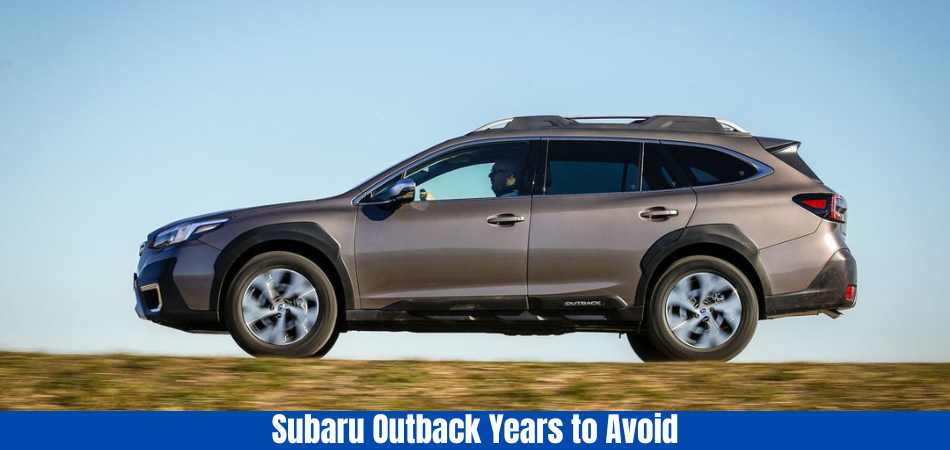
The Forester is still in service in 96% of the vehicles sold within the last ten years. In terms of performance, the Forester is outperformed only by one other car from the same manufacturer.
The award for dependability goes to Subaru’s midsize SUV. Subaru’s Outback is the longest-running model among its models. Data from the last decade shows that 97 percent of Outback models are still in use.
What are the Most common Subaru Outback problems?
1. Increasing oil consumption
The increased oil consumption experienced by some Subaru Outback owners is a significant problem. This issue is particularly prevalent in fifth-generation models with 2.5-litre engines and third-generation models with 2.5-litre and 3.0-litre engines.
In the first 100,000 miles, a blown head gasket is usually the cause of this issue. It is essential to monitor oil levels closely and address any signs of excessive consumption promptly to prevent engine damage in Outback vehicles.
2. Faults in the electrical system
Various electrical systems are available on the newer generations of the Subaru Outback due to modern technology. Although these features enhance the driving experience, they can also cause electrical system problems.
There have been reports of radio malfunctions and infotainment system problems among fifth- and sixth-generation Outback owners. Electrical connections are usually loose when these problems occur.
The best way to resolve these issues and ensure that the vehicle’s electrical system operates smoothly is by consulting a car electrician.
3. Failed cooling system
The cooling system failure reported in specific Subaru Outback model years is often linked to head gasket leaks.
It affects primarily third- and fifth-generation Outback models. Malfunctioning water pumps are frequently responsible for ineffective coolant circulation between the engine and the radiator.
The engine temperature may increase significantly, potentially causing overheating. Inspections of the cooling system regularly and prompt attention to any problems can prevent serious engine damage.
4. Problems with Transmission
Additionally, the Subaru Outback model years from 2010 to 2013 experienced transmission problems.
Transmission slipping and harsh shifting are common complaints, and 2013 models have been known to leak oil due to faulty piston rings. Repairing these transmission faults often requires a complete rebuild, making it one of the most expensive repairs for Outback owners.
When transmission problems develop, seeking professional assistance as soon as possible is essential since the average cost is $2500 to $3000.
Is Subaru Outback Fuel Efficient?
Several factors affect Subaru Outback’s fuel economy, including the engine selected, the road’s conditions, and the driver’s driving habits. Compared to similar-sized cars in its class, the Outback generally offers reasonable fuel efficiency.
Fuel efficiency is typically better in newer vehicles, especially those with continuously variable transmissions (CVTs) and more efficient engines. If you are considering a particular model and engine combination, checking out its fuel efficiency statistics is always a good idea.
Tips for Buying a Used Subaru Outback
Research and be aware of potential issues before purchasing a used Subaru Outback. Making an informed decision is easier if you follow these tips:
1. Avoid Problematic Years: You should avoid models from 2011, 2013, 2014, and 2020.
2. Get a Vehicle History Report: Vehicle history reports contain valuable information about a car’s past, including accidents, damage, and recalls.
3. Have the Car Inspected: A trusted mechanic inspects the car before purchasing. In addition to identifying potential issues, they can also give you an idea of the vehicle’s overall condition.
How Do You Maintain Your Subaru Outback in Good Health?
You can maintain Subaru Outback’s good health by following these steps:
- Prevent rust and corrosion by regularly cleaning the terminals of the batteries and the nearby areas.
- As a general rule, you should change the oil every 3,000 miles.
- It is essential to check the coolant cylinder. If the fluid becomes dirty, it should be changed. Adding antifreeze every 2-3 years is a good idea.
- Make sure the maintenance services you hire are good.
Conclusion: Subaru Outback Years To Avoid
Now you have an idea of which Subaru Outback Years to Avoid. Many Subaru vehicles are reliable and long-lasting. Subaru consistently ranks among Consumer Reports’ top 10 most dependable car manufacturers. Buying any model from it is simple.
Would you prefer a sedan or hatchback model of the Legacy or Impreza? Can the Forester or Outback be considered a compact or midsize SUV? You can drive any Subaru model ten years from now, and it will still work correctly.
Read more of our articles here.
Read also: Subaru Outback AWD
FAQs
Is every Subaru Outback from the mentioned years unreliable?
No, not necessarily. Having issues with a particular year does not mean every vehicle from that year will experience them. Despite this, it is essential to be aware and take preventative measures when possible.
Is Subaru aware of the issues with specific years of the Outback?
Subaru has acknowledged some of the problems with recalls and service campaigns. You should always check with your local dealer or the automaker for specifics.
Does my Subaru Outback have any recalls?
You can view active recalls using your vehicle’s VIN by visiting the official Subaru website or the National Highway Traffic Safety Administration (NHTSA) website.
Do I need to sell my Outback from one of the “years to avoid”?
The answer is no. If your vehicle has been well-maintained and shows no signs of problems, it might still serve you well. Maintaining your vehicle can be proactive if you are aware of potential problems.
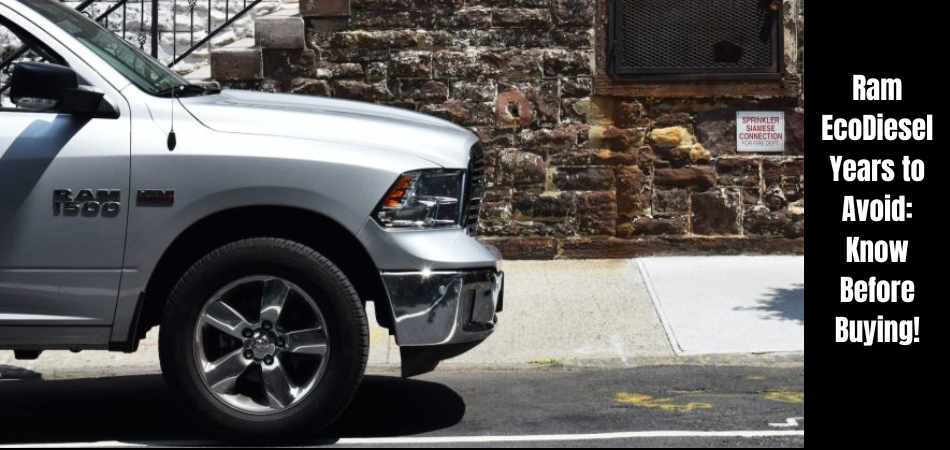
The Ram EcoDiesel is a well-known pickup truck in history, and its reliability separates it from the competition. Power and output are both boosted with EcoDiesel, which is a unique powertrain that consumes less fuel and provides more horsepower and torque. Bu,t which Ram EcoDiesel years to avoid?
Dodge Ram EcoDiesel pickup trucks are among the most reliable vehicles. It can be a work truck, a city truck, or a combination of both. Only a few Ram EcoDiesel models have serious problems, but knowing the Ram EcoDiesel years to avoid can save yourself some stress.
RAM EcoDiesel Technology
RAM EcoDiesel technology debuted on RAM EcoDiesel models in 2014, but it has been improving every year to provide New Lenox drivers with a more fuel-efficient driving experience. Among the smart features of modern technology are:
- Grille shutters by Active Air®
- Heads with aluminum twin cams
- The latest technology in clean diesel
- Blocks of compacted graphite iron
- Compatibility with B20 biodiesel
RAM EcoDiesel Review
What about the RAM EcoDiesel makes it such a force on Tinley Park’s roads? The compression ratio of diesel engines is high, while the spark plugs of standard gasoline engines are simple. Diesel engines operate at high compression ratios, which allow fuel combustion to occur almost instantly, resulting in higher output without energy loss. Towing and torque capacities are impressive, thanks to the more powerful RAM EcoDiesel engine. Here are the specs for the 3.0L RAM EcoDiesel:
- Horsepower: 240
- Torque: 420 lb-ft
- Max towing capacity: 9,290 lbs
RAM EcoDiesel MPG
In addition to receiving high-octane power, you will also save money at the gas pump with the EcoDiesel lineup! Having a high torque performance, the RAM EcoDiesel engine produces better gas mileage than most gasoline engines. In general, higher torque produces more power per gallon, resulting in fewer fill-ups. Here are some recent best-in-class fuel economy estimates:
- RAM EcoDiesel 4×2 MPG – 29 mpg highway, 21 mpg city
- RAM EcoDiesel 4×4 MPG – 27 mpg highway, 21 mpg city
Which Ram EcoDiesel Years to Avoid?
There are specific years of Dodge RAM EcoDiesel models that should be avoided at all costs. While Dodge Ram EcoDiesel models often perform admirably, users should use caution because not all models are reliable. So which Ram EcoDiesel years to avoid?
You should avoid buying some Dodge RAM EcoDiesel years since they have a few issues that can be very uncomfortable.
If you were to buy a new car, you would need to consider the cost of repairing the engine and other issues. It is best to avoid them altogether; do not attempt to fix them.
Continue reading to find out which Dodge RAM EcoDiesel years you should avoid.
Best Ram EcoDiesel Models
EcoDiesel models that should be avoided are easy to identify, but it is equally important to recognize the ones that excel as well. If you want a truck that’s going to last, we recommend the Best Ram EcoDiesel Models.
Taking a closer look at the specifics will be helpful.
1. 2018 RAM EcoDiesel
There is no doubt that the 2018 RAM EcoDiesel is the best model. Additionally, the truck was not only fixed for engine issues, but it is also reliable and efficient. Due to the redesign, customers were more attracted to the design, and all the tech features are hard to complain about. This RAM will likely disappoint you if you are looking for a solid diesel truck.
There are 11 trim levels to choose from, which means more options are available. Only three trim levels – Express, Night, and Rebel – are available with EcoDiesel.
2. 2020 RAM EcoDiesel
One of the first models in the fifth generation is the 2020 model. As part of the new release, the car received updated tech features, a stronger frame, improved suspension, and a coveted interior design. Currently, the 3.0L EcoDiesel V6 offers a great combination of fuel economy and towing ability. Diesel models such as this one are often regarded as the best of their type.
RAM updated the EcoDiesel model for the 2020 model year. In addition to being more powerful and fuel-efficient, the new model is better rated for emissions.
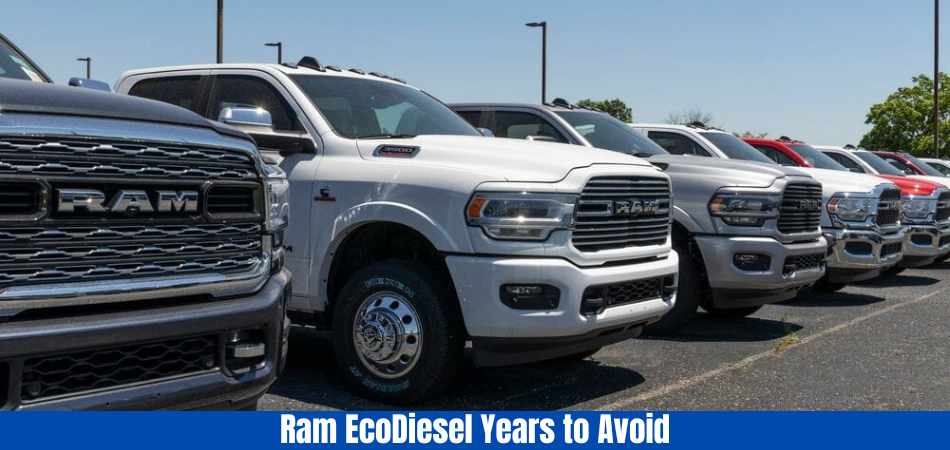
3. 2019 RAM EcoDiesel
You know that all of the bugs have been worked out with a complete redesign. It provides maximum reliability with the value you want. The majority of customers praise the comfortable ride, but it’s also important to mention the exceptional fuel economy. You won’t have to sacrifice comfort or money with this truck. It’s designed to handle tough jobs, no matter how tough they may be.
This truck was able to be lighter due to RAM’s efforts. In addition to increasing payload and towing capacity, this weight reduction enhanced the fuel efficiency of the vehicle.
4. 2021 RAM EcoDiesel
As the follow-up to the 2020, this truck comes with even more technology and safety features. The vehicle is also capable of towing and has plenty of power.
Owners of this truck won’t even notice that they’re even driving a pickup thanks to the premium materials in the cabin. Furthermore, this truck has a longer expected lifespan than others, so it should last a long time.
5. 2017 RAM EcoDiesel
The 2017 RAM EcoDiesel is another reliable option. You can still find it for a decent price these days, and it still has plenty of life left in it. Although it may not have as many luxury features as the newer models, you won’t have to worry about its performance.
This is the first EcoDiesel engine with a reliable performance. You are dealing with serious issues before this.
Most Common Problems With The Dodge Ram EcoDiesel
1. TIPM Issues
Modern Dodge Ram pickups come with integrated power modules, also called TIPMs. Powered by this one source, all EcoDiesel truck’s electrical components can be operated. You probably know what to expect in the event of a system failure.
If a TIPM fails:
- Despite airbags being meant to protect you in a collision, they sometimes fail to deploy.
- No one can predict exactly when the horn will sound.
- There will be malfunctions or spontaneous openings of the power-operated windows.
- After the vehicle is turned off, the fuel pump may continue to operate.
- Despite spinning, the starter motor does not engage.
- Locks and unlocks unexpectedly when an automatic door is opened.
- There is a possibility that the cooling system’s fans will fail.
- ABS may be having a problem.
- Breakdowns of the air conditioner are possible.
- The radio can shut off unexpectedly while driving.
2. Cam And Lifter Failure
This problem was also causing a lot of concern among users. A certain model of Dodge Ram pickup manufactured around 2010 experienced unexpected engine seizures.
In cases where the truck stalls when stopping, stalls at idle, or seizes up unexpectedly, cam and lifter failure is one of the most commonly reported issues.
The issue also affects more recent models. In this case, you should use the warranty to fix the problem. When the warranty on the truck expires, the cost of fixing this issue typically becomes unaffordable. Over $3,500 in expenses is not uncommon.
3. Coolant Leakage Issues
Coolant began leaking from Ram trucks in 2015. Because coolant prevents the engine from overheating, this is a major problem. The engine will overheat if there isn’t enough oil in it, causing the car to stall in the middle of the road and shortening its life.
A leaking gasket or hose can cause coolant to leak from a Ram EcoDiesel. The problem is hard to fix because it’s challenging to find the root cause.
Various factors can cause coolant to leak, including gaskets, heater hoses, and water pump hoses. Since it’s not always obvious where a leak originates, this can be one of the most frustrating things to fix. The cost of repairing these leaks is difficult to predict since they tend to occur repeatedly.
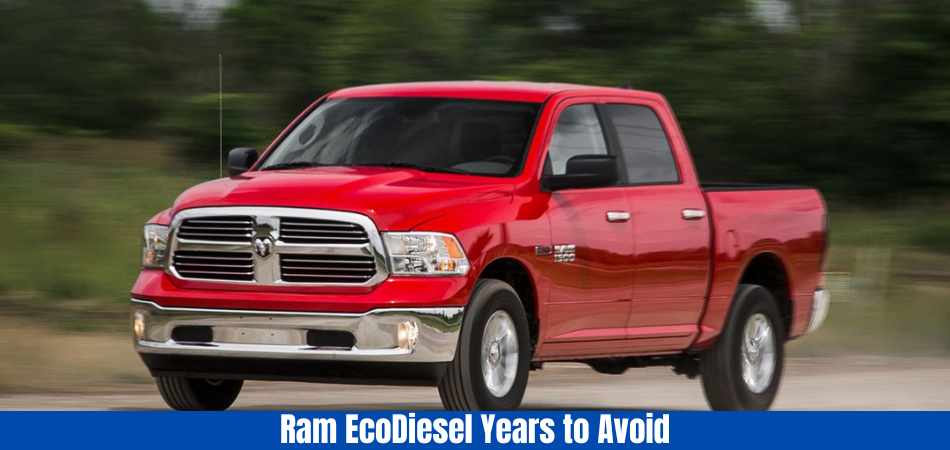
4. Body Structure Issues
It is no secret that Dodge uses subpar components. It was a severe problem in the truck’s 2014–2017 models, but there are hardly any reports.
While none of these problems affect the truck’s performance, they make owning less convenient. The presence of rust alone can significantly shorten a truck’s service life. Several purchasers also complained about minor problems, such as flickering lights when doors were opened and closed or water leaking when it rained.
Several problems with RAM pickups are newer:
- There is a problem with the trunk’s lock, which causes it to open when it shouldn’t.
- The holes in the bumper were incorrectly sized.
- A paint job with bubbles underneath is defective.
- Damage to the upper wheels and the exterior wheelhouse of the bed.
- In addition to compromising the vehicle’s safety, rust can reduce its performance.
5. Transmission Problems
It is common for Dodge Ram EcoDiesel owners to complain about transmission problems. The transmission can cause problems with the performance of the engine and difficulty starting the vehicle. Almost every variation of the trucks that are not recommended suffers from these issues.
There are a variety of ways in which transmission problems can manifest in these trucks.
- Starts slowly.
- There is a problem with the engine.
- Getting into first gear hard.
- When changing gears, jerk the steering wheel.
- Traffic slipping into gear.
- In order to stop, you need to shift down hard while slowing down.
How Many Miles Will a Ram EcoDiesel Last?
Whether you are buying a Dodge Ram EcoDiesel or any other make, it is important to know its estimated lifespan before purchasing. It has been reported that Ram EcoDiesels can last a long time, according to many Ram EcoDiesel owners.
Despite being rugged and suitable for hauling and towing, the trucks require extra care and maintenance.
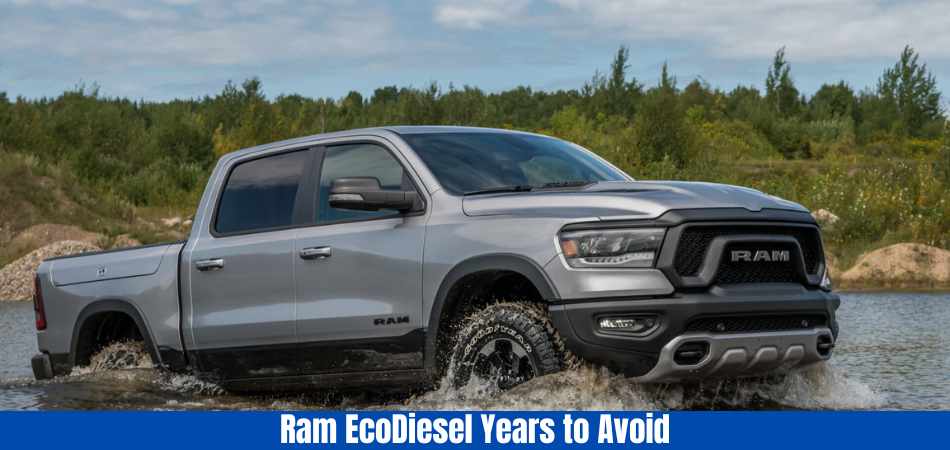
You can get more than 250,000 miles from your Dodge Ram EcoDiesel if you maintain it properly. There have been some trucks whose lifespan has exceeded 300,000 miles in real life.
It is possible to add more miles to the Ram EcoDiesel by performing a few maintenance tasks. It is essential to flush the coolant, change the oil, and change the transmission fluid regularly to protect various engine components.
Regularly changing the oil can prolong the life of any engine by preventing friction between metal parts.
There is no doubt that Dodge Ram EcoDiesel trucks are as popular as Ford F and Chevy Silverado trucks. The Ram EcoDiesel’s ever-high ranking on the market shows that people love it, among other things.
Why is Ram discontinuing the EcoDiesel?
The production of the RAM EcoDiesel EcoDiesel engine ended in January 2023. While the vehicle has been around for almost a decade, it’s becoming more electrified in the future. Consequently, drivers looking for reliable EcoDiesel models are sure to flood the used truck market.
Should You Buy the Ram EcoDiesel?
Diesel engines have a longer lifespan than gasoline engines thanks to Ram EcoDiesel’s dependability.
Ram EcoDiesel comes with a basic warranty of three years and 36,000 miles and a powertrain warranty of five years and 100,000 miles. There is a 22 mpg city rating and a 32 mpg highway rating for the EcoDiesel EcoDiesel.
Your EcoDiesel EcoDiesel should last a very long time if you maintain proper fluid levels, perform regular maintenance, and keep it up to date. Owners estimate the mileage to be between 200,000 and 300,000.
There are many Ram packages and sets that are compatible with EcoDiesel. TorqueFlite’s eight-speed transmission shifts seamlessly at all speeds. The vehicle looks rugged, is quiet inside, and can tow a trailer.
Conclusion: Ram EcoDiesel Years to Avoid
There are always problems with trucks, as anyone who owns one knows. Despite being generally a reliable truck, the Dodge Ram EcoDiesel can have problems that make it difficult to work, or even cost you money. The Dodge Ram EcoDiesel has been a popular and sometimes reliable truck in the U.S. since it was introduced in 1997.
So far, they have proven to be great choices. All of the features of the car are excellent, including the new air ride suspension and the infotainment system. You should pay attention to the year you buy, and then everything will be fine.
Read more of our articles here.
Read also: RAM 1500 EcoDiesel Model Overview.
FAQs
1. What year did Ram fix the EcoDiesel?
During the third generation of EcoDiesel, they fixed it. It was also available in the Jeep Wrangler and Jeep Gladiator. EcoDiesel’s third generation engine was completely redesigned.
2. Why did Ram stop EcoDiesel?
Final production runs honor the EcoDiesel’s achievements and provide loyal enthusiasts with a chance to own their favorite trucks. RAM is focusing on electrification as it looks to the future.
3. Which is better Hemi or EcoDiesel?
There is a significant difference in fuel efficiency between the 3.0 Ecodiesel V6 and the 5.7 Hemi 1500. On the highway, it has a fuel economy of 9.05 L/100km and in the city, 12.38 L/100km. Due to its larger towing capacity without an eTorque system, ecodiesel trucks are preferred by those who need them to tow and haul.
4. Does Ram EcoDiesel use diesel fuel?
When you want a vehicle that can handle your jobs or off-roading near Shiprock, check out the RAM EcoDiesel. It comes with a diesel V6 engine option. With incredible power and exceptional features, the new RAM 1500 EcoDiesel is the perfect vehicle for your next road trip.
5. Is EcoDiesel better than diesel?
In addition to providing great fuel economy ratings, these engines produce higher horsepower and torque outputs than gasoline-powered engines. While they are more powerful than traditional gasoline engines, they are more eco-friendly than diesel engines.
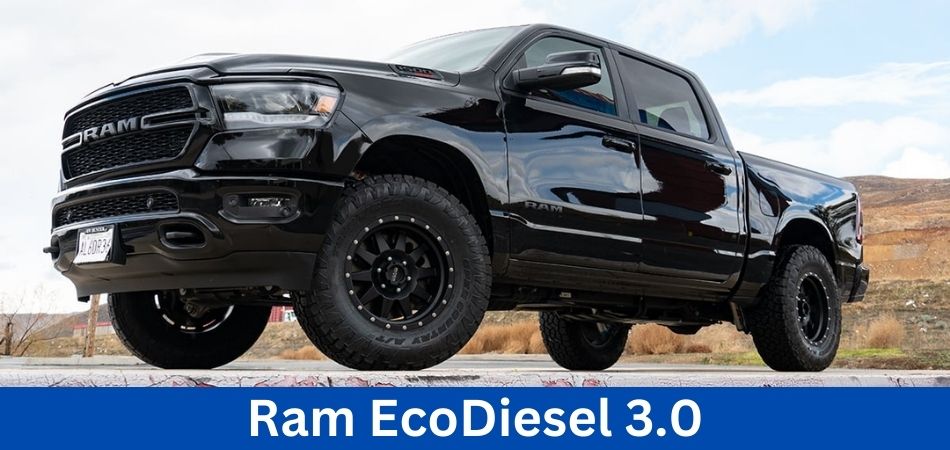
The Ram EcoDiesel is a well-known pickup truck in history, and its reliability separates it from the competition. Power and output are both boosted with EcoDiesel, which is a unique powertrain that consumes less fuel and provides more horsepower and torque. Bu,t which Ram EcoDiesel years to avoid?
Dodge Ram EcoDiesel pickup trucks are among the most reliable vehicles on the market. It can be a work truck, a city truck, or a combination of both. There are only a few Ram EcoDiesel models that have serious problems, but by knowing the Ram EcoDiesel years to avoid, you can save yourself some stress.
RAM EcoDiesel Technology
RAM EcoDiesel technology debuted on RAM EcoDiesel models in 2014, but it has been improving every year to provide New Lenox drivers with a more fuel-efficient driving experience. Among the smart features of modern technology are:
- Grille shutters by Active Air®
- Heads with aluminum twin cams
- The latest technology in clean diesel
- Blocks of compacted graphite iron
- Compatibility with B20 biodiesel
RAM EcoDiesel Review
What about the RAM EcoDiesel makes it such a force on Tinley Park’s roads? The compression ratio of diesel engines is high, while the spark plugs of standard gasoline engines are simple. Diesel engines operate at high compression ratios, which allow fuel combustion to occur almost instantly, resulting in higher output without energy loss. Towing and torque capacities are impressive, thanks to the more powerful RAM EcoDiesel engine. Here are the specs for the 3.0L RAM EcoDiesel:
- Horsepower: 240
- Torque: 420 lb-ft
- Max towing capacity: 9,290 lbs
RAM EcoDiesel MPG
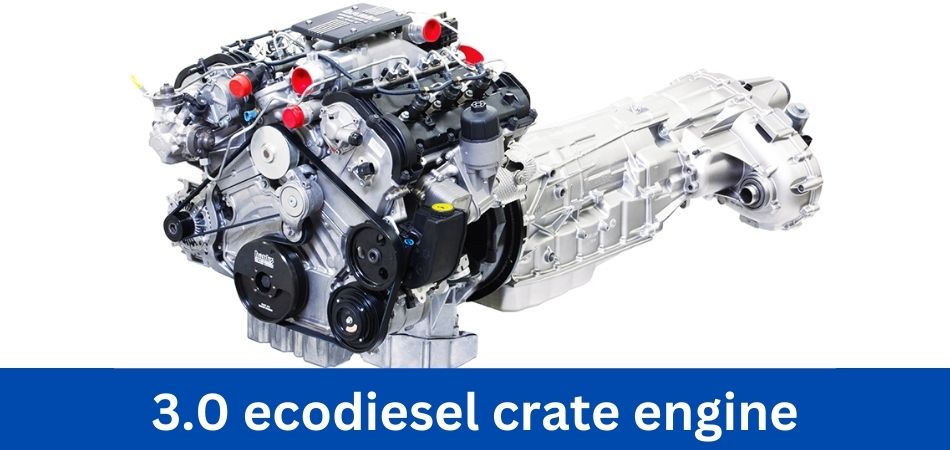
In addition to receiving high-octane power, you will also save money at the gas pump with the EcoDiesel lineup! Having a high torque performance, the RAM EcoDiesel engine produces better gas mileage than most gasoline engines. In general, higher torque produces more power per gallon, resulting in fewer fill-ups. Here are some recent best-in-class fuel economy estimates:
RAM EcoDiesel 4×2 MPG – 29 mpg highway, 21 mpg city
RAM EcoDiesel 4×4 MPG – 27 mpg highway, 21 mpg city
Which Ram EcoDiesel Years to Avoid?
There are specific years of Dodge RAM EcoDiesel models that should be avoided at all costs. While Dodge Ram EcoDiesel models often perform admirably, users should use caution because not all models are reliable. So which Ram EcoDiesel years to avoid?
You should avoid buying some Dodge RAM EcoDiesel years since they have a few issues that can be very uncomfortable.
If you were to buy a new car, you would need to consider the cost of repairing the engine and other issues. It is best to avoid them altogether; do not attempt to fix them.
Continue reading to find out which Dodge RAM EcoDiesel years you should avoid.
Best Ram EcoDiesel Models
EcoDiesel models that should be avoided are easy to identify, but it is equally important to recognize the ones that excel as well. If you want a truck that’s going to last, we recommend the Best Ram EcoDiesel Models.
Taking a closer look at the specifics will be helpful.
1. 2018 RAM EcoDiesel
There is no doubt that the 2018 RAM EcoDiesel is the best model. Additionally, the truck was not only fixed for engine issues, but it is also reliable and efficient. Due to the redesign, customers were more attracted to the design, and all the tech features are hard to complain about. This RAM will likely disappoint you if you are looking for a solid diesel truck.
There are 11 trim levels to choose from, which means more options are available. Only three trim levels – Express, Night, and Rebel – are available with EcoDiesel.
2. 2020 RAM EcoDiesel
One of the first models in the fifth generation is the 2020 model. As part of the new release, the car received updated tech features, a stronger frame, improved suspension, and a coveted interior design. Currently, the 3.0L EcoDiesel V6 offers a great combination of fuel economy and towing ability. Diesel models such as this one are often regarded as the best of their type.
RAM updated the EcoDiesel model for the 2020 model year. In addition to being more powerful and fuel-efficient, the new model is better rated for emissions.
3. 2019 RAM EcoDiesel
You know that all of the bugs have been worked out with a complete redesign. It provides maximum reliability with the value you want. The majority of customers praise the comfortable ride, but it’s also important to mention the exceptional fuel economy. You won’t have to sacrifice comfort or money with this truck. It’s designed to handle tough jobs, no matter how tough they may be.
This truck was able to be lighter due to RAM’s efforts. In addition to increasing payload and towing capacity, this weight reduction enhanced the fuel efficiency of the vehicle.
4. 2021 RAM EcoDiesel
As the follow-up to the 2020, this truck comes with even more technology and safety features. The vehicle is also capable of towing and has plenty of power.
Owners of this truck won’t even notice that they’re even driving a pickup thanks to the premium materials in the cabin. Furthermore, this truck has a longer expected lifespan than some others, so it should last you a long time.
5. 2017 RAM EcoDiesel
The 2017 RAM EcoDiesel is another reliable option. You can still find it for a decent price these days, and it still has plenty of life left in it. Although it may not have as many luxury features as the newer models, you won’t have to worry about its performance.
This is the first EcoDiesel engine with a reliable performance. You are dealing with serious issues before this.
Most Common Problems With The Dodge Ram EcoDiesel
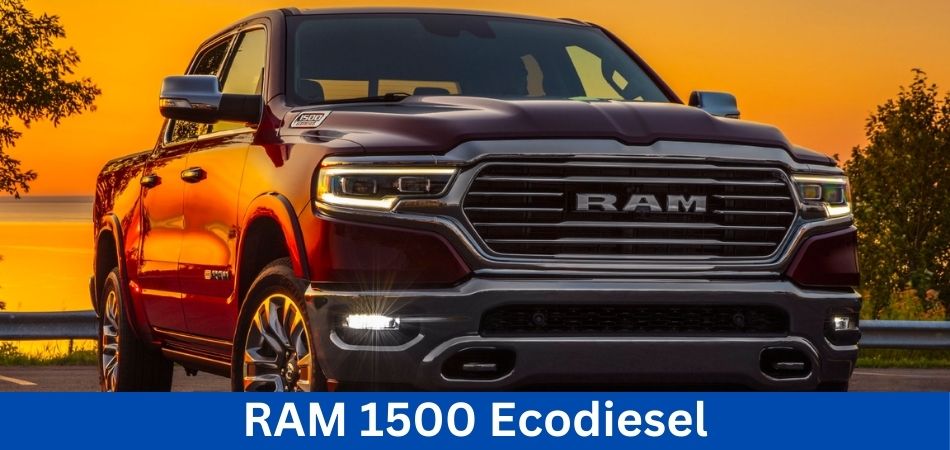
1. TIPM Issues
Modern Dodge Ram pickups come with integrated power modules, also called TIPMs. Powered by this one source, all EcoDiesel truck’s electrical components can be operated. You probably know what to expect in the event of a system failure.
If a TIPM fails:
- Despite airbags being meant to protect you in a collision, they sometimes fail to deploy.
- No one can predict exactly when the horn will sound.
- There will be malfunctions or spontaneous openings of the power-operated windows.
- After the vehicle is turned off, the fuel pump may continue to operate.
- Despite spinning, the starter motor does not engage.
- Locks and unlocks unexpectedly when an automatic door is opened.
- There is a possibility that the cooling system’s fans will fail.
- ABS may be having a problem.
- Breakdowns of the air conditioner are possible.
- It is possible for the radio to shut off unexpectedly while driving.
2. Cam And Lifter Failure
This problem was also causing a lot of concern among users. A certain model of Dodge Ram pickup manufactured around 2010 experienced unexpected engine seizures.
In cases where the truck stalls when stopping, stalls at idle, or seizes up unexpectedly, cam and lifter failure is one of the most commonly reported issues.
The issue also affects more recent models. In this case, you should use the warranty to fix the problem. When the warranty on the truck expires, the cost of fixing this issue typically becomes unaffordable. Over $3,500 in expenses is not uncommon.
3. Coolant Leakage Issues
Coolant began leaking from Ram trucks in 2015. Because coolant prevents the engine from overheating, this is a major problem. The engine will overheat if there isn’t enough oil in it, causing the car to stall in the middle of the road and shortening its life.
A leaking gasket or hose can cause coolant to leak from a Ram EcoDiesel. The problem is hard to fix because it’s challenging to find the root cause.
Various factors can cause coolant to leak, including gaskets, heater hoses, and water pump hoses. Since it’s not always obvious where a leak originates, this can be one of the most frustrating things to fix. The cost of repairing these leaks is difficult to predict since they tend to occur repeatedly.
4. Body Structure Issues
It is no secret that Dodge uses subpar components. It was a severe problem in the truck’s 2014–2017 models, but there are hardly any reports.
While none of these problems affect the truck’s performance, they make owning less convenient. The presence of rust alone can significantly shorten a truck’s service life. Several purchasers also complained about minor problems, such as flickering lights when doors were opened and closed or water leaking when it rained.
Several problems with RAM pickups are newer:
- There is a problem with the trunk’s lock, which causes it to open when it shouldn’t.
- The holes in the bumper were incorrectly sized.
- A paint job with bubbles underneath is defective.
- Damage to the upper wheels and the exterior wheelhouse of the bed.
- In addition to compromising the vehicle’s safety, rust can reduce its performance.
5. Transmission Problems
It is common for Dodge Ram EcoDiesel owners to complain about transmission problems. The transmission can cause problems with the performance of the engine and difficulty starting the vehicle. Almost every variation of the trucks that are not recommended suffers from these issues.
There are a variety of ways in which transmission problems can manifest in these trucks.
- Starts slowly.
- There is a problem with the engine.
- Getting into first gear hard.
- When changing gears, jerk the steering wheel.
- Traffic slipping into gear.
- In order to stop, you need to shift down hard while slowing down.
How Many Miles Will a Ram EcoDiesel Last?
Whether you are buying a Dodge Ram EcoDiesel or any other make, it is important to know its estimated lifespan before purchasing. It has been reported that Ram EcoDiesels can last a long time, according to many Ram EcoDiesel owners.
Despite being rugged and suitable for hauling and towing, the trucks require extra care and maintenance.
You can get more than 250,000 miles from your Dodge Ram EcoDiesel if you maintain it properly. There have been some trucks whose lifespan has exceeded 300,000 miles in real life.
It is possible to add more miles to the Ram EcoDiesel by performing a few maintenance tasks. It is essential to flush the coolant, change the oil, and change the transmission fluid regularly to protect various engine components.
Regularly changing the oil can prolong the life of any engine by preventing friction between metal parts.
There is no doubt that Dodge Ram EcoDiesel trucks are as popular as Ford F and Chevy Silverado trucks. The Ram EcoDiesel’s ever-high ranking on the market shows that people love it, among other things.
Why is Ram discontinuing the EcoDiesel?
The production of the RAM EcoDiesel EcoDiesel engine ended in January 2023. While the vehicle has been around for almost a decade, it’s becoming more electrified in the future. Consequently, drivers looking for reliable EcoDiesel models are sure to flood the used truck market.
Should You Buy the Ram EcoDiesel?
Diesel engines have a longer lifespan than gasoline engines thanks to Ram EcoDiesel’s dependability.
Ram EcoDiesel comes with a basic warranty of three years and 36,000 miles and a powertrain warranty of five years and 100,000 miles. There is a 22 mpg city rating and a 32 mpg highway rating for the EcoDiesel EcoDiesel.
Your EcoDiesel EcoDiesel should last a very long time if you maintain proper fluid levels, perform regular maintenance, and keep it up to date. Owners estimate the mileage to be between 200,000 and 300,000.
There are many Ram packages and sets that are compatible with EcoDiesel. TorqueFlite’s eight-speed transmission shifts seamlessly at all speeds. The vehicle looks rugged, is quiet inside, and can tow a trailer.
Conclusion: Ram EcoDiesel Years to Avoid
There are always problems with trucks, as anyone who owns one knows. Despite being generally a reliable truck, the Dodge Ram EcoDiesel can have problems that make it difficult to work, or even cost you money. The Dodge Ram EcoDiesel has been a popular and sometimes reliable truck in the U.S. since it was introduced in 1997.
So far, they have proven to be great choices. All of the features of the car are excellent, including the new air ride suspension and the infotainment system. You should pay attention to the year you buy, and then everything will be fine.
FAQs
What year did Ram fix the EcoDiesel?
During the third generation of EcoDiesel, they fixed it. It was also available in the Jeep Wrangler and Jeep Gladiator. EcoDiesel’s third generation engine was completely redesigned.
Why did Ram stop EcoDiesel?
Final production runs honor the EcoDiesel’s achievements and provide loyal enthusiasts with a chance to own their favorite trucks. RAM is focusing on electrification as it looks to the future.
Which is better Hemi or EcoDiesel?
There is a significant difference in fuel efficiency between the 3.0 Ecodiesel V6 and the 5.7 Hemi 1500. On the highway, it has a fuel economy of 9.05 L/100km and in the city, 12.38 L/100km. Due to its larger towing capacity without an eTorque system, ecodiesel trucks are preferred by those who need them to tow and haul.
Does Ram EcoDiesel use diesel fuel?
When you want a vehicle that can handle your jobs or off-roading near Shiprock, check out the RAM EcoDiesel. It comes with a diesel V6 engine option. With incredible power and exceptional features, the new RAM 1500 EcoDiesel is the perfect vehicle for your next road trip.
Is EcoDiesel better than diesel?
In addition to providing great fuel economy ratings, these engines produce higher horsepower and torque outputs than gasoline-powered engines. While they are more powerful than traditional gasoline engines, they are more eco-friendly than diesel engines.
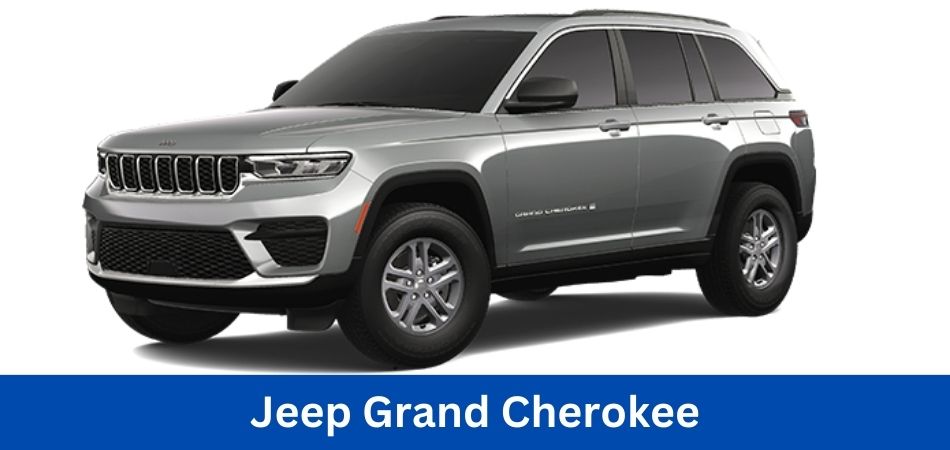
Grand Cherokee is an impressive midsize SUV that boasts a luxurious interior, exceptional off-road and on-road capabilities, remarkable towing capacity, and powerful engines. But what about Jeep Grand Cherokee V6 vs V8?
A Jeep Grand Cherokee with a v6 engine has lower torque, horsepower, towing capacity, and fuel consumption than one with a v8 engine. The V6 engine produces 295 horsepower and 260 lb-ft of torque, tows up to 6,200 pounds, and gets better fuel mileage than a V8. In contrast, the Grand Cherokee v8 engine produces 707 horsepower and 645 pounds-feet of torque, and it can tow up to 7200 pounds.
In this article, we will briefly discuss the major differences between the Jeep Grand Cherokee V6 vs V8. Furthermore, we will discuss which one is more suitable for you. So let’s get started.
Specifications of Grand Cherokee V6
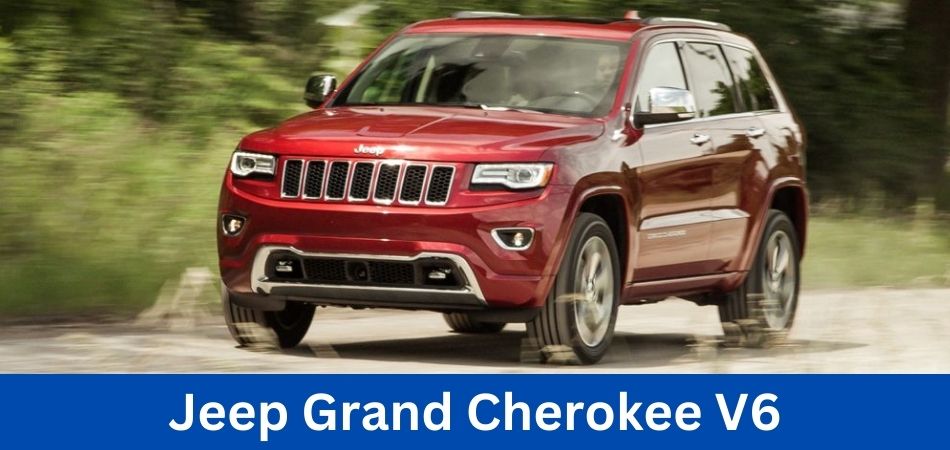
The features that V6 offers are mind-blowing. A V6 has a number of features that will make you appreciate it very much. A V6 has the following specifications:
- There will be two rows of three cylinders in the engine.
- You can rock the roads with the V6’s horsepower.
- As you drive, the V6 engine causes the car to feel nose-heavy.
- It is more stable than any other engine to use a V6.
- V6 is not a problem for you.
- It’s fun to use V6.
Specifications of Grand Cherokee V8
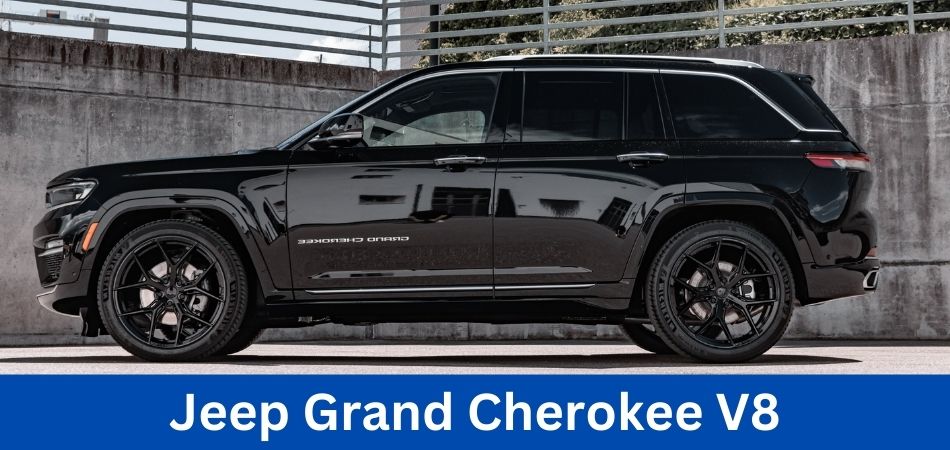
You will also enjoy using V8 because it offers a lot of incredible specifications. The following are listed:
- There are eight engines in a V8.
- The engine of a V8 has two rows of four cylinders.
- The V8 offers a larger cargo capacity, which allows you to carry heavier and larger items.
- There is a lot of power in the V8 engines.
- V8s are very useful for completing worksite tasks.
- It is amazing how much power a V8 can tow.
- It is possible to tow a lot with a V8.
Jeep Grand Cherokee V6 vs V8: Basic Comparison
When buying a new Cherokee, choosing between engine options is a challenging decision.
If you had a V6 engine installed, you’d be paying less, but why not upgrade to a V8 engine? The following information should be helpful to you.
| Feature | V6 Engine | V8 Engine |
| Cylinder Deactivation | Standard Feature | Standard Feature |
| Performance | Suited to Roads | Enhanced Off-Road Performance |
| Torque | 260 lbs per ft | 390 – 645 lbs per ft |
| Horsepower | 295 HP | 360 – 707 HP |
| Towing Capacity | 6200 lbs | 7200 lbs |
| MPG | 19-26 | 11-22 |
Jeep Grand Cherokee V6 vs V8: Detailed Comparison
1. Fuel Efficiency And Everyday Driving
Fuel economy is one of the biggest differences between V6 and V8 engines. Comparing their MPGs is as follows:
- 3.6L V6: Up to 19/26 mpg city/highway
- 5.7L V8: 14/22 mpg city/highway
- 6.4L V8: 13/19 mpg city/highway
So, While the V8s have more horsepower, their fuel economy is significantly lower than the Pentastar V6. In the long run, this can add up to hundreds of dollars in fuel costs each year.
In addition to saving you money at the pump, the V6 is suitable for buyers who do most of their driving in cities and highways. When accelerating up to highway speeds, the V6 feels responsive because of its low-end torque.
An extra power boost from the V8 will only be useful for buyers who frequently need to accelerate quickly with a full load of passengers and cargo.
2. Performance And Power
The V8 engines have a clear advantage when it comes to acceleration and passing abilities:
- 3.6L V6: 0-60 mph in 7.5 seconds (est)
- 5.7L V8: 0-60 mph in 6.3 seconds
- 6.4L V8: 0-60 mph in 4.8 seconds
Additionally, V8s are capable of towing much larger boats, ATVs, snowmobiles, etc. The maximum towing ratings for each engine are as follows:
- 3.6L V6: 6,200 lb towing capacity
- 5.7L V8: 7,200 lb towing capacity
- 6.4L V8: 7,200 lb towing capacity
You can tow up to 7,200 pounds with a V6, while the extra torque of the V8 gives you more power when accelerating.
When it comes to powering heavy loads or towing a large trailer, V8 engines offer the best performance.
3. Off-Roading Ability
In addition to its serious off-roading capabilities, the Jeep Grand Cherokee attracts many buyers. There are a few factors to consider when comparing a V6 with a V8 engine for off-road use:
- Low-end torque – V8s provide more torque at lower RPMs, giving the vehicle more control and traction on steep, rocky trails.
- Ground clearance – No advantage for V8s here, as all engines have the same clearance.
- 4WD systems – All engines are available with identical advanced 4WD systems.
Despite the V8’s higher torque at low RPM, both engines provide robust off-road performance and capability. With the exception of extreme rock crawling, the V6 is plenty powerful.
So, Off-roading is not the sole reason most buyers upgrade to the V8. You should consider the V8 only if you drive up steep grades and over rocks frequently, where low-end power is very helpful.
4. Price And Value Comparison
Cost is one of the most important factors when choosing an engine for your Grand Cherokee:
- 3.6L V6 – Available on most Grand Cherokee models without additional charge.
- 5.7L V8 – A $3,295 upgrade on most trims. Costs are significantly higher.
- 6.4L V8 – Only available on high-end SRT and Trackhawk models starting around $69,000 and $87,000, respectively. The price is much higher.
In light of the substantial upgrade cost of the V8, its benefits need to be weighed against those of the standard V6.
Most buyers prefer the V6 because it offers a lot of power and capability for a lower price. Unless you frequently tow heavy loads close to maximum ratings or desire faster acceleration, the V6 may be a better value.
Towing heavy trailers and loads requires the 5.7L V8, which is a smart upgrade. If you plan on towing near the Grand Cherokee’s 7,200 lb maximum capacity, extra power and torque can justify the added cost.
5. Reliability And Ownership Costs
It’s also important to consider the cost and reliability of your engine over its lifetime.
In many Chrysler, Dodge, and Jeep vehicles, the 3.6L V6 Pentastar engine has proven to be very reliable. The engine may experience minor problems like oil leaks, but it does not have widespread problems. Proper maintenance should extend its life well beyond 100,000 miles.
In addition to its good reliability record, the 5.7L V8 shares the basic design with the 5.7L Hemi in Ram trucks. The lifter tick noise at start-up and occasional oil leaks are potential problems to watch for. Considering it’s a V8, it’s very reliable.
There is little difference between the engines in terms of maintenance costs. Gasoline for V6s is regular, while premium fuel is required for V8s. As a result of more frequent oil changes, spark plug replacements, and brake pad replacements, V8 engines may also have higher maintenance costs than V6 engines.
The V6 and V8 are both reliable options that should serve you for many years to come. In terms of maintenance costs, the V6 may have a slight advantage.
6. Driving Experience
There is a noticeable difference between the driving experience of a V6 and a V8 engine:
There is no noticeable difference in acceleration between the V6 and the V8. The sound is refined at high speeds. Commuting and everyday driving are both perfectly acceptable in terms of performance.
There is just something more livelier about V8s, with effortless acceleration. The sound of the HEMI V8 growl enhances the sense of power. Immediately noticeable is the performance improvement.
Regardless of the engine, the Grand Cherokee is easy to control thanks to its light steering and supple ride. Nevertheless, those who enjoy acceleration and power will find the V8 more enjoyable to drive. In the case of driving enthusiasts who relish the quick responses of the HEMI, the upgrade may be worth the cost.
In contrast, those less concerned with performance may find the V6 to be perfectly adequate. Make sure the fun factor of the V8 is worth the price for you by driving both.
7. Stability and Handling
As a result of its stability and handling qualities, Grand Cherokee is one of the safest SUVs on the road. It makes the vehicle more stable and easier to handle due to the even weight distribution.
Weight distribution is even among V6 Grand Cherokee models. Due to this, driving around corners, curves, and turns is no problem.
With a V6 engine, there is less tendency to drift towards the outer edge while accelerating. Because of fewer cylinders, the car handles better due to its stability.
This engine has more cylinders than the Hemi V8. It tends to interfere with stability and performance when these extra features are present. In this situation, the vehicle may have difficulty accelerating, which might increase the risk of drifting.
The V8 engine is, therefore, difficult to improve in terms of performance. There will be a negative impact on the vehicle’s handling and stability as a result of this issue.
Under this category, the Grand Cherokee with a V6 engine wins. Weight balance is the key to stability and better handling due to the few cylinders. Jeeps are, therefore capable of negotiating tight corners without any problems.
8. Noise Production
An annoying car can produce a lot of noise while driving. Jeep drivers can laugh at you if you make this noise on the highway. Your SUV’s engine type will determine how much noise it produces.
Jeep models with V6 engines usually produce minimal noise when driving. There is no reason to worry about the noise, as it is considered normal. Driving long distances will not cause nerve fatigue due to the reduced noise.
There are numerous cylinders in the V8 engine. The Grand Cherokee generates more power as a result of these additional features. That’s why the sound is so loud. Fortunately, the great noise isn’t caused by mechanical issues.
If In order to have a more peaceful journey, a Grand Cherokee with a V6 engine would be a better choice. The noise it produces is normal and cannot irritate you. V8 engines are, therefore, losers in this category.
What are the Pros and Cons of Jeep Grand Cherokee V6 vs V8
In some ways, the V6 and V8 engines of the Grand Cherokee are very similar. Lightweight and compact, these engines provide high performance.
You need to consider the advantages and disadvantages of these Grand Cherokee models before buying. You can make the right choice by considering these special features and disadvantages.
Pros of Grand Cherokee V6
- Efficient use of fuel
- Affordably priced
- Noise production should be minimal
- Provide powerful towing capabilities.
- Better handling and more stable
Cons of Grand Cherokee V6
- Performance is low
- The toughest terrain is not ideal for this product
Pros of Grand Cherokee V8
- Capable of carrying more cargo
- Powerful at higher ceilings
- Tough terrain is not suitable for this tire
Cons of Grand Cherokee V8
- Increase fuel consumption
- Handles and stabilises poorly
- When driving, make a lot of noise
Which Jeep Buyers Should Choose The V6 Or V8?
Following all of the above factors, here are some recommendations on whether V6 or V8 engines are best for Grand Cherokee shoppers:
Consider the V6 if you:
- Focus on fuel efficiency
- Use your Jeep on a daily basis
- You want to save money on fuel and purchase costs
- Tow light loads or only occasionally
- Enjoy driving in a smooth, refined manner
You Should Choose The V8 If:
- Use the maximum towing rating regularly when towing heavy loads
- You want to accelerate and pass as fast as possible
- Take on steep, challenging terrain while off-roading
- HEMI V8 performance and sound are worth more to you
The V8 offers more power to certain buyers, while the V6 provides plenty of power to most drivers. Choosing the right engine for you requires careful consideration of your needs.
Final Words
With the V6, you get better fuel economy and a more reasonable handling experience. Offroading and challenging situations require better engine performance than V8.
The Grand Cherokee V8 engine produces more noise and consumes more fuel. For off-roading and towing heavy loads, these engines have more power and acceleration.
FAQs
What is the main difference between the Jeep Grand Cherokee V6 and V8?
The main difference is the engine size and power. The V6 has a smaller engine and less power compared to the V8.
Which Jeep Grand Cherokee model is more fuel-efficient, the V6 or V8?
Generally, the V6 is more fuel-efficient than the V8. The smaller engine size of the V6 allows for better fuel economy.
Is there a significant performance difference between the Jeep Grand Cherokee V6 and V8?
Yes, there is a noticeable performance difference. The V8 offers more horsepower and torque, resulting in better acceleration and towing capabilities than the V6.
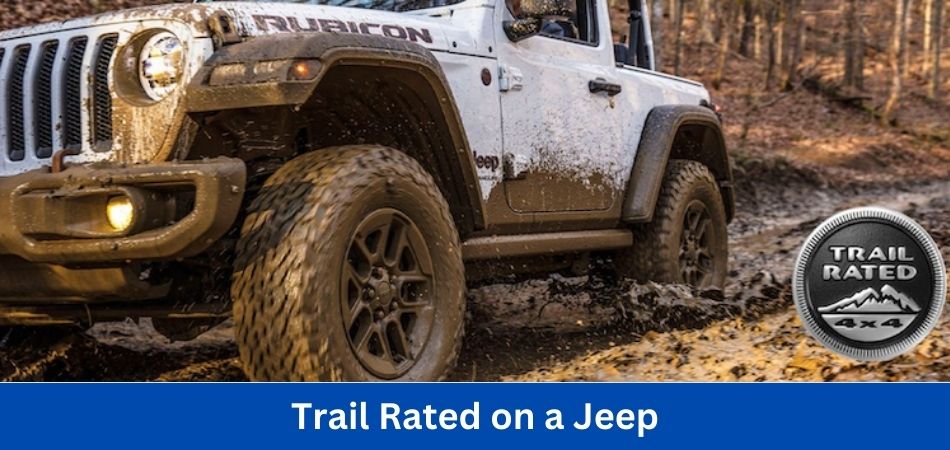
Trail Rated Jeeps altered the way people bought cars when they were initially launched in 2004. Drivers can now purchase a car designed for both road and off-road excursions. The Trail Rated label has come to be recognised as a reliable sign of a vehicle’s durability and adaptability to any situation.
To be Trail Rated, a Jeep must meet tight standards for vehicle traction, manoeuvrability, ground clearance, water fording, and off-road articulation. These characteristics enable a Jeep to endure inclement weather, difficult terrain, and other difficulties without interfering with the driving experience. The Wrangler, Compass, Renegade, Cherokee, and Grand Cherokee are the most recent Jeeps to pass these tests.
How Does a Jeep Earn its Trail Rating?
A Jeep must pass a series of tests to become a Trail Rated vehicle. The majority of these tests take place in Northern Michigan’s snowy, rocky terrain, while others need the Jeep to navigate the Rubicon Trail’s stones.
The performance of a Jeep on these trails is assessed in the following regions.
Traction
Every Trail Rated Jeep has undergone rigorous testing to ensure great traction, allowing for unrivalled stability and control on a range of terrains. These Jeeps are capable of handling hills, uneven roads, and snowy weather with ease. So, whether you want to travel through the boulder-ridden areas of the Rocky Mountains or the wet roads after an iconic snowy Colorado day, a Trail Rated Jeep can accomplish it.
Water Fording
Although most drivers would never bring their car anywhere near a body of water on purpose, Trail Rated Jeep drivers can safely drive through wet terrain. A Trail Rated Jeep has been developed with sealed electric connections and body openings to allow drivers to safely travel across streams, ponds, and other moderate bodies of water. These vehicles also have larger intakes, allowing them to cross shallow water without the risk of water going inside.
Maneuverability
Jeep understands that its fans like to avoid the monotonous, predictable paved and marked roads of cities and highways wherever possible. They prefer the unexpected twists and turns of rugged terrain and everything that comes with it. That implies exceptional manoeuvrability is required to navigate through tight and windy areas securely. As a result, Trail Rated Jeeps have precision steering and adjusted wheelbases for superior control in tense conditions.
Articulation
According to Jeep, articulation refers to “the capacity to sustain as many tires as feasible on the road when travelling over difficult terrain, thus allowing for a more efficient transfer of power.” This is handy in a variety of situations, including highways with numerous potholes or rocky terrain. Keeping all four wheels on the ground increases safety and control. Trail Rated Jeeps must undergo comprehensive testing to ensure that their tires stay in contact with the ground no matter how rocky the road.
Ground Clearance
The distance that separates the undercarriage and the ground is referred to as ground clearance. Good ground clearance is essential while traversing rocks, logs, and other large formations on uneven terrain. And when you take your Jeep out of the city and into the wilderness, you’re bound to run into problems like these. That’s why Trail Rated Jeeps have plenty of ground clearance to keep vital sections of the vehicle from being damaged on rocky terrain.
Furthermore, the approach, breakover, and departure angles of these vehicles have all been optimized. The approach angle is a measurement of how steep a hill can be before a vehicle scratches its underside. The breakover angle is the steepest angle that a vehicle may traverse without causing damage to its underside. The departure angle determines how deep the gradient can be for a vehicle to descend safely.
Each of these parts explains why Jeeps appear to grip and hug stones and rocks with ease when seen in the woods.
Where Does the Trail Rating Testing Occurs?
Trail Rated Jeeps are rigorously tested in two distinct environments: the Rubicon Trail in California’s Sierra Nevada Mountains and Moab, Utah.
The Rubicon Trail is 22 miles long and features twists, turns, boulders, tight pathways, and rocky roadways. Because of the weather fluctuations, the landscape is continuously changing and offering new problems to drivers. This makes it an ideal location for Jeep testing, and Trail Rated Jeeps are brought out onto these grounds numerous times before obtaining their badges.
Moab, Utah, home to numerous breathtaking national parks, is known for its slippery rock surfaces, which make for an excellent challenge for a Jeep. This is another site where Trail Rated Jeep engineers test their vehicles before introducing them to the public.
Which Jeeps Have the Trail Rated Badge?
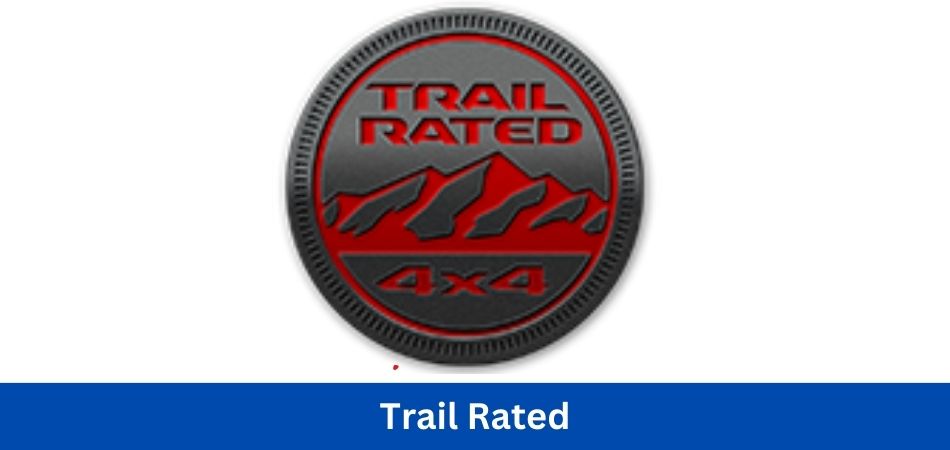
Now that we’ve had your attention to the outstanding capabilities of the tough Trail Rated Jeeps, you’re undoubtedly curious which models received their badge. For 2022, the Wrangler 4xe, Wrangler, Grand Cherokee, Cherokee, Compass, Renegade, and Gladiator all wear the heroic Trail Rated Badge, so if you’re looking for your next ready-for-anything vehicle, these are all excellent choices to test drive.
The Trail Rated® logo on Jeep® models denotes a vehicle that was specially built to conquer the most difficult terrains for adventure seekers and off-road explorers. A vehicle with this badge must pass five important tests: traction, water fording, manoeuvrability, articulation, and clearance from the ground. These are some of the vehicles that have achieved this exceptional rank.
Jeep® Wrangler: The Ultimate Off-Road Icon
The Jeep Wrangler has been regarded as the benchmark for off-road prowess, and it proudly wears the Trail Rated logo across all trim levels. The Wrangler’s tough design, powerful engine options, and modern 4×4 systems allow it to easily navigate rocky trails, steep inclines, and difficult obstacles.
Jeep Grand Cherokee: Luxury Meets Adventure
The Jeep Grand Cherokee blends opulent comforts with off-road aptitude, thus becoming an appealing option for those seeking both comfort and excitement.
Select trims, such as the Jeep Grand Cherokee Trailhawk®, display the Trail Rated emblem, indicating enhanced off-road capability. The sophisticated 4×4 systems, electronic limited-slip differential, and optional air suspension on this flexible Jeep SUV deliver great traction, ground clearance, and handling in a variety of off-road settings.
Jeep Cherokee and Jeep Compass: Compact Capability
Jeep Cherokee and Jeep Compass are tiny SUVs with impressive off-road prowess in a smaller package.
The Jeep Cherokee Trailhawk and Jeep Compass Trailhawk trims are proudly sporting the Trail Rated logo, boasting excellent off-road features such as higher ground clearance, skid plates, and improved 4×4 systems. These vehicles provide drivers with the ideal blend of everyday utility and off-road performance.
What is The Importance of the Trail Rated Badge?
Jeep has been one of the top manufacturers when it comes to manufacturing vehicles that handle rough terrain so well for decades. The Trail Rated testing process begins at Jeep’s headquarters in the United States and ends in some of the world’s most difficult terrain. The firm aims to ensure that every Trail Rated Jeep can handle whatever you throw at it, while also striving for features that will change the way people go off-roading.
Jeep will continue to ensure that consumers have the correct models to handle their every requirement as long as they wish to take their vehicles on excursions.
Test drive one of these Trail Rated badge-winning Jeep SUVs at Fremont Motors. You can select from all of the top models, all of which have Jeep’s powerful four-wheel-drive system and the most up-to-date amenities for convenience, aesthetics, and driving enjoyment.
Why does Jeep perform the Trail Rated test?
Jeep is confident of its off-road abilities, and they’re not hesitant to flaunt it! Jeep has long been known for producing vehicles with exceptional off-road capabilities. Off-road enthusiasts and reviewers alike consider Jeep to an extremely high standard. Jeep launched the Trail Rated program in 1994 to reassure Jeep customers and detractors that the off-road capability would remain excellent. The Trail Rated testing are in place to examine the vehicle’s off-road capability and ensure that drivers know the automobile is as good as Jeep claims.
Why Trail Rated Jeeps Are Ideal Off-Roading Vehicles?
Many automakers create high-performance 4x4s that can handle any terrain. But when you think of off-roading, you probably think of Jeep. Since the 1940s, this automaker has produced famous off-road vehicles, and many specialists still favour the Wrangler, Gladiator, or Renegade over all other makes and models.
Do you ever question why Jeeps make such great off-road vehicles? What makes them so popular? Here are three explanations as to why this car firm distinguishes out from the crowd.
Short Wheelbase
When compared to other cars, a short wheelbase indicates that the rear and front wheels are closer together. This arrangement enables faster, tighter turns.
The wheelbase of the Jeep Wrangler ranges from 96.8 to 118.5 inches. The Gladiator has one that measures 137.3 inches, while the Renegade has one that measures 101.2 inches. What do these figures mean? A two-door Wrangler’s wheelbase is approximately four feet shorter than that of equivalent SUVs. The length difference has a substantial impact on off-road performance, making Jeep more stable when off-roading.
Superior Suspension
Jeep vehicles have solid axles, which are favored for off-roading. Each side of the vehicle has a solid axle that runs right through it. While most 4x4s have this configuration, Jeep has used this suspension technology for decades.
This design is more resilient and less prone to harm from rough terrain. This is due to the fact that it is more sturdy and requires fewer pieces to repair if necessary.
Hardy Drivetrain
Have you ever seen movies of a Jeep defying gravity and driving vertically up a rock face? This achievement is made possible by a tough drivetrain. The transmission, driveshaft, axles, and wheels comprise this system.
It collaborates with the engine to provide power to the wheels. Off-roading requires a powerful drivetrain, and Jeep routinely equips their 4x4s with cutting-edge technology.
Because of the brand’s devotion to developing outstanding 4x4s, it’s clear to see why Jeeps are ideal off-roading vehicles. Consider TopLift Pros’ Jeep hardtop cover and lift equipment if you want to improve the look of your Jeep. The ability to customise these vehicles is a significant reason why so many people like them.
.
What are the Benefits of a Trail Rated Jeep
A stock Jeep is a fantastic Jeep because it provides you with something that is completely capable of numerous missions right out of the box. Still, more importantly, it allows you to get acquainted with your vehicle and select how you want to alter or personalise it for your mission. Stock Jeeps offer an abundance of parts, a large number of repair shops that are experienced with the brand, and warranty coverage if you have a new car.
Safety
Jeep’s factory safety requirements must be followed, and Jeep must abide by them. Adding a lift, altering wheel size, or customising your Jeep’s drive system may influence the safety standards against which your vehicle has been tested. Knowing your car adheres to or exceeds factory safety criteria gives you peace of mind. While anything might go wrong with any car, Mopar parts are of sufficient quality as well as consistency to be trusted. I’ve heard numerous accounts of catastrophic part breakdowns and death wobbling from modded Jeeps when owners cut shortcuts and purchased cheaply to obtain the appearance but avoid the price. Take precautions and be cautious. It’s your life on the road.
Warranty
A new Jeep Factory warranty is an excellent method to keep costs under control. While many Jeep owners enjoy “wrenching” their vehicles, others prefer the peace of mind that a warranty provides for the first few years. You may jeopardise your warranty coverage if you modify your truck.
Parts in plenty
There are plenty of OEM and third-party parts available. With a standard Jeep, you don’t have to worry about if your boutique bespoke lift will have spares two years down the line or if they’ll even be in business. With everyone eager to modify their Jeeps, stock owners profit from an endless supply of free parts. People frequently give away free factory parts because there are so many accessible, with everyone customising their Jeep.
Speaking of parts, the easiest way to locate Jeep Parts at deep discounts is to join one of the many Jeep Groups on Facebook, keep an eye out for Jeep Parts on Craigslist, and join a Jeep club in your region. At times, I’m blown away by the community and the support and parts exchange network that exists on the internet.
Tips for Off-Roading in Your Trail Rated Jeep
Understand Your Vehicle
Basic off-roading knowledge will only go you so far. It’s a good idea to read up on the hobby, which includes looking over your car’s manual. This will assist you understand what your Jeep is capable of, such as ‘ground clearance’ or the capacity to engage four-wheel drive.
It’s also a good idea to test your vehicle on a relatively easy path. Nothing would be worse than coming at a fantastic path and having to raise the white flag after only a few minutes. First, learn the fundamentals of how your vehicle performs on mud and gravel roads. Next, put your vehicle through its paces on tight roads, inclines, and even creeks (if they’re accessible). This will help you understand what your Jeep can and cannot accomplish.
Finally, you should conduct some study on the roads you’ll be driving on. This can help you anticipate what to expect, as well as identify an optimal path for your excursion. Remember to check the weather as well!
Recognize the Situation
The Jeep website provides an excellent off-roading guide that concentrates on specific situations and route types. While different four-wheel drive vehicles may offer different guidance, we’ll stay with Jeep’s suggestions for this exercise.
Sand: reduce the air pressure in your tires by 10-12 pounds. To help sustain forward momentum, use high-range four-wheel drive if possible. Take broader curves as possible, as tight turns may cause you to become trapped!
Hills: Always drive directly up or down and never at an angle. Don’t try your Jeep if the hill appears steep and you’re not sure it can make it to the summit. If you become caught on your way up, simply back down the hill in reverse.
If you manage to reach the summit, ensure that you apply extra force at the bottom. As you approach the peak, let up on the gas, and then utilize the lowest gear (on manual transmission) as you descend.
The brakes should only be employed to “fine-tune” your speed, as your gears and engine compression should handle deceleration.
Rock Crawling: The best speed for rock crawling is one to three miles per hour, so take off the accelerator and let your Jeep simply crawl. Use a low-range four-wheel drive and consider decreasing your tire pressure by three to five pounds. Understand your ground clearance and use it to decide whether or not to drive over a large rock. If you can’t (and don’t try), drive slowly around the rock.
Snow/mud: This is when your Jeep’s four-wheel drive capabilities come into play. For driving through deep, wet sludge, a low-gear and low-range four-wheel drive is ideal, as it ensures steady motion.
If you lose traction, turn the steering wheel back and forth. Stop the car if you believe you have fully lost traction. In these cases, wheel spinning rarely assists and usually makes matters worse.
Prepare yourself
Aside from ensuring that your Jeep is fully prepared (which includes securing the batteries, ensuring that all parts are in good condition, checking oil and fuel, and inspecting your tires), you’ll want to be prepared for anything may occur. That involves having all of the necessary tools.
Make sure you have a decent tow strap in case you get trapped (assuming someone is nearby), a folding shovel in case you get stuck (assuming no one is nearby), an air pressure gauge, Allen wrenches, lubricant, and anything else you think will aid you in an emergency.
Pretend you’re packing for an overnight trip when it comes to various personal goods. It’s a good idea to pack some extra food, water, and blankets in case you are stuck. You should also bring some spare components and a first-aid kit. It is always preferable to be prepared!
There’s a narrow line between overpacking and underpacking. You need to ensure that you have enough supplies in case of an emergency, but take caution. Overpacking your Jeep may result in poor balance and extra stress.
Use a heavy-duty strap rather than a bungee cord to secure all of these objects. You’ll be riding over a lot of bumps, so make certain none of your resources fall out of the Jeep. Furthermore, these flying objects may collide with you or one of your passengers, inflicting catastrophic injury.
One more thing to carry on an off-road Jeep adventure: a friend. While it’s great to have someone sit in the passenger seat, it’s actually more beneficial to have them drive beside you (provided they have a sufficient vehicle). This ensures that if you become stuck, someone will be there to help you. Bring a CB or FRS radio with you to make the ride more enjoyable. This will render your ride safer because you’ll have a way to communicate with someone if something goes wrong.
Be Aware
It’s an excellent plan to maintain your head on a swivel. According to Jeep.com, if you concentrate entirely on your left wheel, your right wheel is likely to become stuck. Don’t be afraid to convert to four-wheel drive if you foresee any rough terrain. It’s tough to switch to a four-wheel drive after you’re trapped, so plan ahead of time.
You’re going to be off-roading to have a great, exciting day. There’s no incentive to rush through it, and doing so may get you stranded! As previously stated, crawling along while having your low-range four-wheel drive engaged should keep you moving. It isn’t extremely fast, but it is going to keep you and your car safe.
Conclusion
Finally, the title “Trail Rated” on a Jeep represents more than simply a marketing catchphrase; it represents a stringent set of off-road requirements that a Jeep model must meet in order to showcase its capability in a variety of hard terrains. The Trail Rated emblem ensures Jeep enthusiasts that the vehicle has undergone comprehensive testing to tackle the hardest routes with confidence, from traction and water fording to manoeuvrability and articulation. Selecting a Trail Rated Jeep not only demonstrates a commitment to adventure but also ensures a driving experience that defies convention, thereby becoming a symbol of rugged adaptability and off-road proficiency in the world of automobile exploration.
FAQs
What does “Trail Rated” mean on a Jeep?
“Trail Rated” is a designation indicating a Jeep’s off-road capability, meeting specific criteria for traction, ground clearance, maneuverability, articulation, and water fording.
How is Trail Rated different from other off-road labels?
Trail Rated is a Jeep-specific certification, ensuring superior performance in various off-road conditions. It encompasses a range of demanding tests for true off-road prowess.
What tests do Jeeps undergo to earn the Trail Rated badge?
Jeeps go through rigorous evaluations, including traction on challenging terrain, water fording capabilities, articulation to handle uneven surfaces, ground clearance, and maneuverability on tight trails.
Does every Jeep model receive the Trail Rated designation?
No, not every Jeep model is Trail Rated. The designation is reserved for specific models that meet or exceed the demanding off-road performance standards set by Jeep.
How does Trail Rated benefit Jeep owners?
Trail Rated Jeeps are equipped to handle tough off-road conditions, providing confidence to drivers exploring challenging terrains. It signifies a commitment to rugged capability and durability.
How can I identify if a Jeep is Trail Rated?
Look for the distinctive Trail Rated badge on the vehicle. It’s a recognizable symbol indicating the Jeep’s capability and readiness for challenging off-road environments.
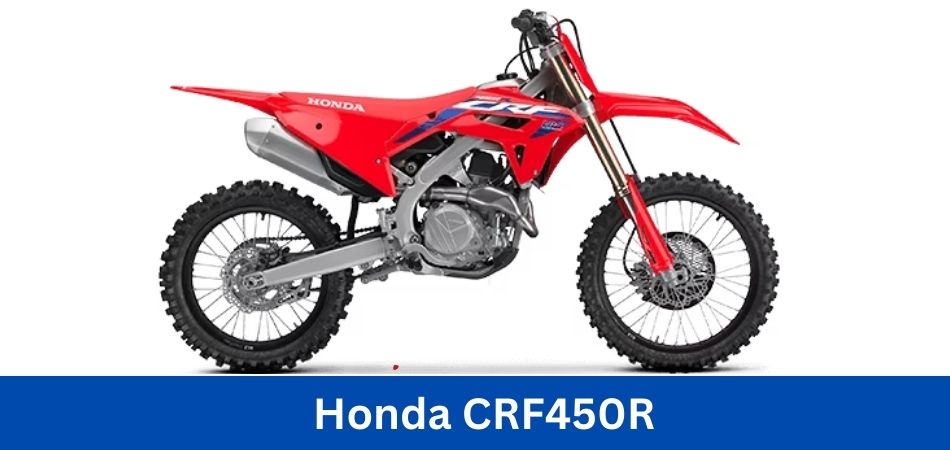
Honda produces excellent bikes that will give you the best adrenaline rush. It’s the Honda CRF450R we’re talking about. This bike is a true masterpiece from one of the world’s best motorcycle manufacturers due to its fullness, lightweightness, and superb performance. The Honda CRF450R top speed is also exceptional.
Honda CRF450R is a popular motocross bike in its class, and the new model comes with plenty of updates. It has a single-cylinder UNICAM engine and a five-speed gearbox with a close ratio. Similar to the smaller Honda CRF150R, this motocrosser features a fresh design. Honda offers two more variants of the CRF450R, S & RWE, for $9,599 each.
We will be taking a closer look at the Honda CRF450R Top Speed, Specs, and Review here in this article. Additionally, we will discuss the bike’s advantages and disadvantages. There will also be ways to speed up the process. Let’s begin.
Overview of Honda CRF450R
The CRF450R was first unveiled in 2002 by Holda. In 2004, the first generation of the CRF450R ended its production after two years. CRF450R has an aluminum frame, upgraded camshaft, and upgraded exhaust system compared to previous generations. Additionally, the handlebars measured 22mm wider than those on the original bike.
From 2005 to 2008, the second-generation CRF450R was available. These bikes had Honda’s new Progressive Steering Damper. This resulted in a more aggressive geometry. Fuel injection was available from 2009 to 2012. Fourth-generation Honda CRF450Rs (2013-1016) have dual exhausts.
A few major changes were made in the Honda CRF450R 5th generation (2017-2020). With a new engine design, the bike also had an eclectic optical start. There were now Showa forks on the bikes. In 2021, Honda released the sixth generation of the CRF450R, further advancing its innovation. With a slimmer profile and a plastic design, this new-generation bike stands out from the competition.
| Price | $9,599 |
| Engine | 4-Stroke, single-cylinder |
| Displacement | 449cc |
| Transmission | 5-Speed |
| Power | 55.2 hp |
| Seat Height | 38 inches |
| Curb Weight | 244 pounds |
| Fuel Tank Capacity | 1.7 gallons |
What are the Specifications of the Honda CRF450R?
Engine and Transmission
There are two overhead camshafts on the 449cc liquid-cooled UNICAM engine in the CRF450R. Besides the fuel injection system, it also gets a 46 mm downdraft throttle body. It has a hydraulic 8-plate clutch assembly and a 5-speed close-ratio gearbox. This 450cc motocrosser features an electric starter and a DC-CDI ignition system. Powered by a four-stroke Unicam engine, the Unicam delivers plenty of power and torque. A simple button push can also engage the HRC launch control system.
| Engine Type | Four-stroke, single-cylinder, 4-valves |
| Engine Displacement | 449cc |
| No. of Cylinders | 1 |
| Fuel Type | Gasoline |
| Fuel Supply | Programmed fuel injection |
| Cooling System | Liquid cooling |
| Bore | 96 mm |
| Stroke | 62.1 mm |
Horsepower & Top Speed
According to Honda, the CRF450R produces 55.2 horsepower at 9,300 rpm and 35.1 lb-ft of torque at 7,300 rpm. With the push of a button on the handlebar, you can choose between three different engine modes: standard, smooth, and aggressive. It also comes with Honda selectable torque control, which is an excellent safety feature. The top speed of the Honda CRF450R in fully stock condition is 87 mph.
Body & Suspension
Due to Honda’s fine-tuning, the CRF450R now has a more responsive, updated, lightweight chassis. The frame is also lightweight, and the swingarm is compact. It features a 49mm Showa inverted fork at the front with rebound and compression damping adjustments. A Pro-Link Showa single-shock absorber at the rear end with adjustable spring preload. The latest model offers improved handling thanks to its optimized suspension.
| Body Type | Motocross |
| Chassis | Narrow frame with lightweight subframe |
| Front Suspension | 49 mm Inverted Showa forks |
| Rear Suspension | Pro-Link Showa single shock |
| Front Wheel Travel | 12.2 inches |
| Rear Wheel Travel | 12.4 inches |
Brakes & Wheels
Front-wheel disc brakes measure 260 mm, and rear-wheel disc brakes measure 240 mm on the Honda CRF450R. There are 21-inch wheels on the front and 19-inch wheels on the rear. On both ends, the CRF450R rides on premium Dunlop MX33 tires. Its front tires measure 80/100-21, while its rear tires measure 120/80-19.
| Front Brake | Single disc with 2-piston caliper |
| Rear Brake | Single disc |
| Front Brake Diameter | 260 mm |
| Rear Brake Diameter | 240 mm |
| ABS | No |
| Front Wheel | 21 Inch spoke rim |
| Rear Wheel | 19 Inch spoke rim |
Dimensions
An 85.9-inch body length and 58.3-inch wheelbase make up the dimensions of this motocrosser. Despite its 49.9-inch total height, the Honda CRF450R does not have a low seat height. The fuel tank holds 1.7 gallons of fuel and offers 13.2 inches of ground clearance. With all standard equipment, the CRF450R has a curb weight of 244 pounds.
| Wheelbase | 58.3 inches |
| Length | 85.9 inches |
| Width | 32.6 inches |
| Height | 49.9 inches |
| Seat Height | 38.0 inches |
| Ground Clearance | 13.2 inches |
| Curb Weight | 244 lbs |
| Fuel Tank Capacity | 1.7 gallon |
What are the Best Features of the Honda CRF450R?
A NARROW, LIGHT FRAME
Honda’s CRF450R chassis puts you out front when it comes to handling, which starts with a solid frame. Firstly, it’s lighter than the previous generation by over a pound and a half. Making the frame’s main spars narrow saves weight, but more importantly, fine-tunes the chassis’ lateral rigidity to make it more responsive. As a result, the bike gets into, around, and out of corners more quickly.
A NEW ENGINE HANGER
As of 2023, the cylinder-head engine hangers have been strengthened, and the frame thickened where the hangers attach. For better handling, the entire assembly is now more rigid.
POINTS FOR MOUNTING THE SUSPENSION
The chassis and suspension are more stable this year thanks to more robust suspension mounting points. A good suspension means a good chassis and a good chassis means better drive and handling.
ONE-PIPE EXHAUST
It is common for Honda CRF450Rs to have single-pipe headers in addition to single-muffler exhausts. As a light overall construction, its route is close to the bike’s center, enhancing the weight distribution.
HYDRAULIC CLUTCH
Honda’s CRF450R dirtbike clutch is the first hydraulically actuated clutch outside of its works bikes. Designed by Nissin, it performs better than third-party conversions and is the same as in our Grand Prix MX machines. Even though it comes with an eight-plate clutch, the clutch lever pull is ten percent lighter at its peak.
HRC LAUNCH CONTROL
With this special ECU program, you press the button to select the mode, hold the throttle open, release the clutch, and the Honda CRF450R takes care of the rest, launching you into the turn with enormous confidence. Using it makes your bike a holeshot machine!
Honda SELECTABLE TORQUE CONTROL (HSTC)
With the Honda Selectable Torque Control (HSTC) button located on the handlebar, you can change the torque. You can choose from three settings to dial in your bike according to the available traction.
ELECTRIC STARTER
Kickstarting? If you’re riding in the vintage class, it might be possible, but not here. The Honda CRF450R can be made lighter by ditching Kickstarter altogether. Putting electric starters and lithium-ion batteries on a bike like this is a win-win combination. A CRF450R is all about winning.
What is the Honda CRF450R Top Speed?
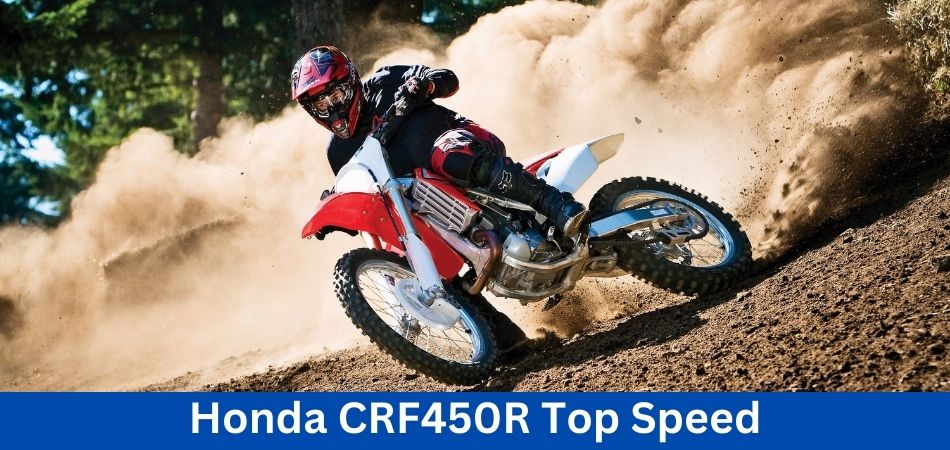
One of Honda’s first innovations was off-road motorcycles, known today as dirt bikes. Honda isn’t usually thought of as having the fastest machines today. Most people are familiar with Honda because of its reliability.
Nevertheless, Honda’s professional riders, such as Chase Sexton and the Lawrence brothers, have been proving otherwise.
A CRF450R can reach a top speed of 80-90 mph.
The top speed of the CRF450R is about 10-20 mph higher than the top speed of the CRF250R and about 5-10 mph higher than the top speed of the YZ250. Having said that, there are a few factors that have a big impact on this CRF450R’s top speed.
What are the Factors Affecting Honda CRF450R Top Speed?
Modifications to the CRF450R can increase top speed, but other factors can also affect it. When riders are heavier, their maximum speed is generally lower than when they are lighter. Track conditions can also affect lap times, as a track with more corners and technical sections will cause lap times to be slower and top speeds to be lower.
How Do You Increase the Honda CRF450R Top Speed?
The Honda CRF450R is undoubtedly one of the fastest dirt bikes in the world. The bike can reach up to 87 mph speeds, making it faster than many commuter bikes. We don’t see any problem with a better Honda CRF450R.
We’re talking about faster acceleration, higher power, and less jerking. That sounds interesting, doesn’t it? As a result, you will learn about some modifications in the following sections. Adding these mods to your Honda CRF450R can take it to the next level.
1. Piston Mod
The first modification you can make to your Honda CRF450R is to replace the piston. It’s not about making the Honda CRF450R better but about improving the stock pistons. Put JE Pistons 14:1 pistons in place of the stock pistons.
You will gain more power in the low to mid-range with these high-compression pistons for your Honda CRF450R. You can try Wiseco Pro-Lite 4-Stroke Piston – Stock Bore 12:1 Compression if you can’t find the piston we mentioned. The piston kit can also improve the performance of your Honda CRF450R.
2. Clutch Mod
There has always been a problem with the clutch on Honda CRF450Rs. Honda still neglects this area, I’m not sure why. Just because Honda neglects doesn’t mean you will! Therefore, you should get a better clutch. For a clutch pack, we recommend Rekluse TorqDrive.
Fan favorite; easy winner; no question. Installing this clutch will immediately remove all the judder from the Honda CRF450R’s spring clutch. There are extra steel plates and fiber absorbers included with the Rekluse TorqDrive clutch pack. This addition effectively absorbs excess heat and significantly reduces jerking.
The Tusk Competition Clutch Kit is another clutch pack. This is something to consider! Kits like this are designed to give you that extra edge when hitting the trails hard, such as during competitions. The kit also includes friction material made from Aramid fibers. In addition to being highly heat resistant, this material is also highly durable. Aside from that, the high-quality steel plates within this kit prevent heat from distorting and warping.
3. Exhaust Mod
This mod increases mid-range power. Do you want to boast? You can get FMF Factory’s 4.1 RCT Single Exhaust System. Your Honda CRF450R will be complete with this kit upgrade, approved by many users. With this, you can go through all those corners with full power. Additionally, do you dislike the raspy noises that the stock exhaust makes? It will dramatically improve the sound!
4. Sprocket Upgrade
Would you like to have higher power at a low cost? Changing the sprocket is all it takes. In the Honda CRF450R, the stock sprocket has 48 teeth. You will see a drastic change in power if you simply change the sprocket for one with 50 teeth. Your bike will accelerate better if you have the other tooth so that you will go faster.
What are the Pros and Cons of the Honda CRF450R?
Pros of the Honda CRF450R
1. There is nothing better than the speed of the Honda CRF450R! The speed is 87 mph. There is no doubt that this bike is fast. You might not be able to handle this bike if your skills are beginner-level. This is a warning!
2. One of the best things about this bike is how reliable it is with its performance. Your speed will remain the same regardless of how hard or long you ride. No matter how badly it is beaten, this bike won’t compromise its power or speed.
3. The quality of Honda’s construction is among the best in the industry. Even though it is very slender and light, the frame is strong. Regardless of how challenging the ride or rush, this bike can handle it!
4. This bike is incredibly slender. Despite having 200cc less power, this bike weighs and looks like the CRF250R. The way Honda managed to pack so much power into this bike makes it truly mesmerizing!
5. Despite being very light and slim, this bike is well-balanced. As a result, hitting those high jumps will not cause you to be off-balance. In addition, the bike has a low center of gravity, which makes it easier to keep up with the group.
Cons of the Honda CRF450R
1. This bike has inconvenient side panels due to its pointed appearance. Despite their appealing appearance, you’ll be in trouble if any of these ever get stuck to your pants. You highly recommend keeping the pointy side panels in mind.
2. This bike has everything narrow except for the foot pegs. Our reason for saying almost is the wide footpegs we don’t understand. With such wide footpegs sticking out of a bike with a slimmer body, it looks odd.
What is the Price of the Honda CRF450R?
Even though the Honda CRF450R occupies the top spot in its class, it’s not overly expensive compared to other bikes in the same category. Its MSRP of $7,599 is $50 more than Kawasaki’s KX450F, $100 more than Suzuki’s RM-Z450, and $200 more than Yamaha’s YZ450F $7399. Is there anything more you could ask for?
Which Bikes Are the Competitors of Honda CRF450R?
As a top-of-the-line MX bike, Honda needs another rival to compete against it. The KX450F from Kawasaki fits the popular MX mold in every way. Honestly, these two bikes look nearly the same except for some minor color differences. The reason for this is that they are designed for competition, after all, and to be honest, all the major players have opted for a similar aesthetic.
With a 28.2-degree rake and 5 inches of trail, the Honda is just a hair wider/longer than the CRF’s 27.22-degree/4.6-inch rake, which will make it more maneuverable. Featuring an inverted Showa SFF-Air TAC fork with DLC-treated sliders and compression/rebound damping adjustments, Kawi supports the KX.
A Showa mono shock at the rear provides compression, rebound damping, and preload adjustability, and components at both ends offer 12 inches of travel at the axle. With its 270 mm discs up front, the Kawi has an ever-so-slight advantage over the CRF’s 260 mm.
Kawi also keeps its power numbers close to the vest, but the 12.8-to-1 compression ratio indicates a colder engine with lower output. Both engines carry 449cc, water-cooled engines. KXs lack EMSB, but they have Launch Control that retards sparks in the bottom two gears for increased traction during that critical takeoff, and they both have accessories to tune their engines.
Kawi won a small victory with an MSRP of $8,849, just under the CRF. Savings may not be enough to overcome brand loyalty, especially for those working up to the 450 class.
Conclusion: Honda CRF450R Top Speed
One of the fastest and most powerful motocrossers in this segment is the new Honda CRF450R. There are several hardware upgrades as well as a new paint scheme. Performance and acceleration are furious thanks to the single-cylinder engine. In addition to riding aids like launch control, torque control, and engine modes, riders benefit from various riding aids. With its all-round performance and great handling, the Honda CRF450R is a great choice.
FAQs
How fast will a 450 dirt bike go?
A 450cc dirt bike can reach 80-120mph speeds, making it a great choice for recreational and enduro riding. One of the fastest is a 450cc dirt bike with a fuel-injected, 4-stroke, four-valve DOHC engine and a 5-speed gearbox with a multi-plate wet clutch.
What is the top speed of the CRF450L?
Despite its top speed of 90 mph, the CRF450L doesn’t feel like it will explode at 60 mph. You can easily do some miles on the highway with the right tires.
Are 450 faster than 250?
The performance of 450cc bikes is much better than that of 250cc bikes, but choose your bicycles based on your weight, height, and riding ability, not just the speed.
How heavy is a CRF450?
It weighs approximately 244 pounds (including all standard equipment, necessary fluids, and a full fuel tank, ready to ride.)
Is a CRF450R a 4-stroke?
It is the successor to the Honda CR250R, a two-stroke racing motocross motorcycle built by Honda Motor Company.












About